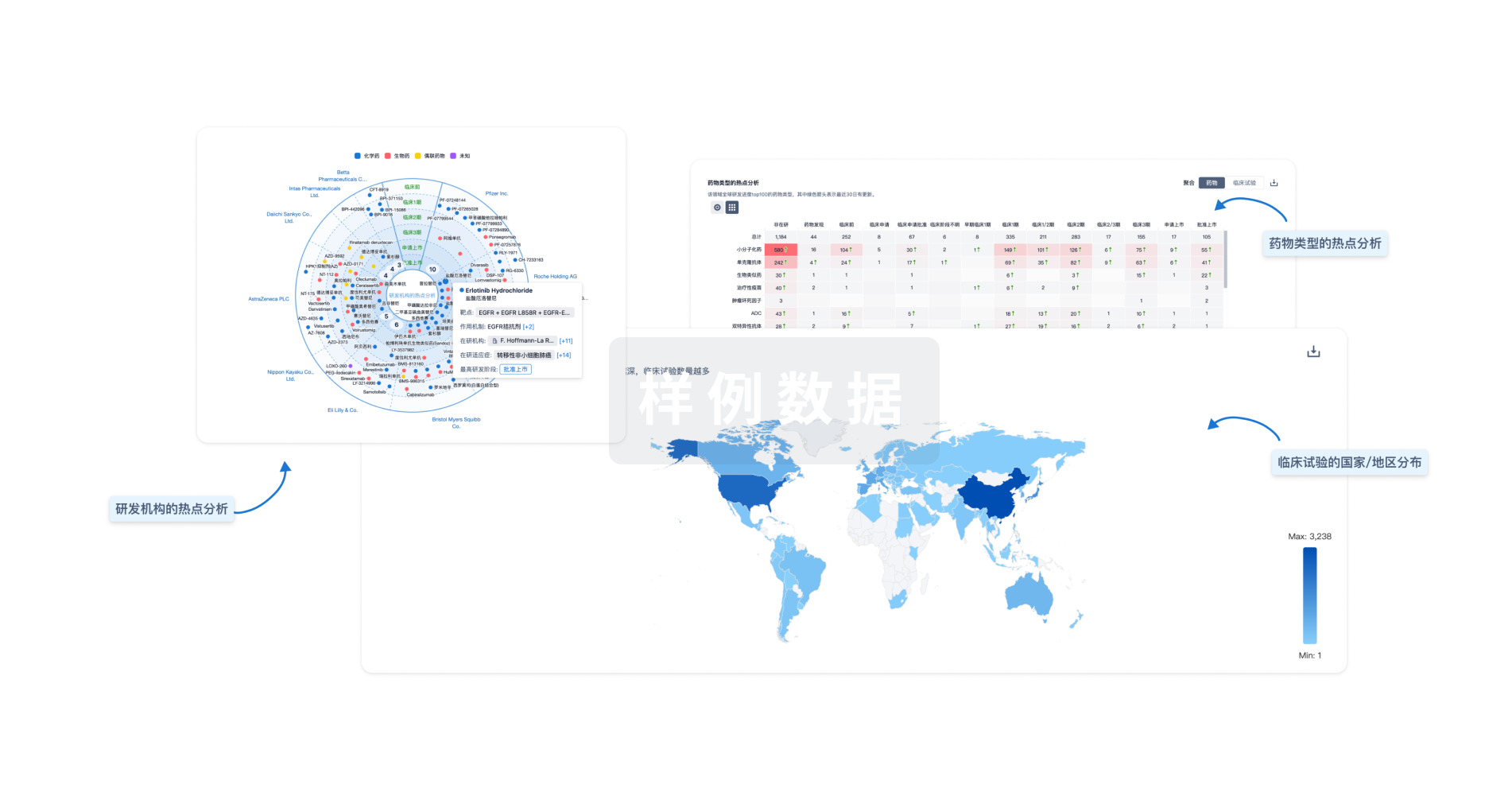预约演示
更新于:2025-05-07
Tuberculosis, Miliary
粟粒性结核
更新于:2025-05-07
基本信息
别名 MTB - Miliary tuberculosis、Miliary TB、Miliary Tuberculoses + [29] |
简介 An acute form of TUBERCULOSIS in which minute tubercles are formed in a number of organs of the body due to dissemination of the bacilli through the blood stream. |
关联
3
项与 粟粒性结核 相关的药物靶点- |
作用机制- |
在研机构 |
原研机构 |
在研适应症 |
非在研适应症- |
最高研发阶段临床前 |
首次获批国家/地区- |
首次获批日期1800-01-20 |
靶点- |
作用机制- |
原研机构 |
在研适应症 |
非在研适应症 |
最高研发阶段临床前 |
首次获批国家/地区- |
首次获批日期1800-01-20 |
靶点 |
作用机制 OXSM inhibitors |
在研适应症 |
非在研适应症- |
最高研发阶段药物发现 |
首次获批国家/地区- |
首次获批日期1800-01-20 |
12
项与 粟粒性结核 相关的临床试验CTRI/2024/02/063109
A study of the Stigma, Barriers, and Facilitators associated with Treatment and Follow-up of Tuberculosis Patients in Coastal Karnataka - NIL
开始日期2024-04-01 |
申办/合作机构- |
CTRI/2024/01/061325
Establishing TB portal of Mycobacterium tuberculosis patients from tertiary care hospital in Southern India. - NIL
开始日期2024-01-13 |
申办/合作机构- |
CTRI/2023/08/056619
Empirical antibiotic prescription pattern in community acquired infections among critically ill patients in a tertiary care centre - NIL
开始日期2023-08-28 |
申办/合作机构- |
100 项与 粟粒性结核 相关的临床结果
登录后查看更多信息
100 项与 粟粒性结核 相关的转化医学
登录后查看更多信息
0 项与 粟粒性结核 相关的专利(医药)
登录后查看更多信息
3,032
项与 粟粒性结核 相关的文献(医药)2025-05-01·Medical Clinics of North America
Severe Tuberculosis
Review
作者: Muzanyi, Grace ; Bark, Charles M
2025-05-01·Radiology Case Reports
Tuberculous hemorrhagic meningoencephalitis. A rare manifestation of miliary TB. Case report and review
Article
作者: Elsayed, Ayman ; Hamzeh, Layth Raafat ; Hajjar, Baraa
2025-04-22·The American Journal of Tropical Medicine and Hygiene
Clinical Features and Outcomes of Tuberculosis after in Vitro Fertilization–Embryo Transfer Compared with Natural Pregnancy: A Retrospective Study
Article
作者: Wen, Jiayu ; He, Jian-Qing
4
项与 粟粒性结核 相关的新闻(医药)2025-04-25
一项发表于《柳叶刀-全球健康》(The Lancet Global Health)的国际多中心临床试验表明,新型结核疫苗MTBVAC在成人中表现出与卡介苗相似的安全性,并诱导更强的免疫反应,为结核病防控提供了潜在新选择。截图来源:The Lancet Global Health结核病仍是全球重大传染病。现有卡介苗可保护儿童免遭严重和粟粒性结核的侵害,挽救了数百万人的生命。但卡介苗在青少年和成人中预防空洞性肺结核的效果欠佳。因此仍需有效的成人疫苗来控制结核病。世界卫生组织已将“开发针对成人和青少年的新型结核病疫苗”列为全球卫生优先事项。MTBVAC是一种减毒活疫苗,通过基因改造保留了更多结核分枝杆菌抗原。这项单中心、双盲、剂量递增的1b-2a期试验(NCT02933281)在南非社区招募了143名18-50岁、既往接种过卡介苗的HIV阴性成年人,随机分配接受MTBVAC(四种剂量)或卡介苗复种(5×105 菌落形成单位[CFU]剂量),评估其安全性和免疫原性。主要终点包括7天内自发性全身不良反应和28天内非自发性不良反应等,次要终点为疫苗免疫原性。结果显示:• 注射部位反应(疼痛、红肿)随MTBVAC剂量增加而增多,但在相似剂量下,5×105 CFU剂量组的不良事件比例(96%)与卡介苗组(96%)相当。未报告疫苗相关严重不良事件。• 所有剂量的MTBVAC均具有免疫原性;MTBVAC诱导的抗原特异性CD4 T细胞应答在接种28天后达峰值,其中5×105 CFU剂量组和5×106 CFU剂量组中,表达Th1细胞因子的的CD4 T细胞应答显著高于卡介苗(无论是否为结核分枝杆菌致敏人群)。5×105 CFU剂量的MTBVAC在安全性上与传统BCG相似,免疫原性更优,被推荐进入后续疗效试验。这一成果为开发更有效的结核疫苗提供了重要证据。点击文末“阅读原文/Read more”,即可访问The Lancet Global Health官网阅读完整论文。推荐阅读欢迎投稿:学术成果、前沿进展、临床干货等主题均可,点此了解投稿详情。题图来源:123RF参考资料[1] Luabeya, A. K. K., Rozot, V., Imbratta, C., et al. (2025). Live-attenuated Mycobacterium tuberculosis vaccine, MTBVAC, in adults with or without M tuberculosis sensitisation: a single-centre, phase 1b-2a, double-blind, dose-escalation, randomised controlled trial. The Lancet Global Health. https://doi.org/10.1016/S2214-109X(25)00046-4免责声明:本文仅作信息交流之目的,文中观点不代表药明康德立场,亦不代表药明康德支持或反对文中观点。本文也不是治疗方案推荐。如需获得治疗方案指导,请前往正规医院就诊。版权说明:欢迎个人转发至朋友圈,谢绝媒体或机构未经授权以任何形式转载至其他平台。转载授权请在「医学新视点」微信公众号留言联系。如有其他合作需求,请联系wuxi_media@wuxiapptec.com分享,点赞,在看,传递医学新知
疫苗临床结果临床2期
2024-12-19
·药时空
疫苗的引入深刻改变了公共卫生领域,尤其是自20世纪60年代国家免疫计划首次得到妥善建立与协调以来。在疫苗覆盖率高的国家,许多曾导致多数儿童死亡的疾病已基本消失(图1)。免疫接种作为公共卫生政策的基石,对于儿童健康的保护具有极高的成本效益。
图 1 | 疫苗接种对英国某些疾病的影响
引入针对白喉(a 部分)、荚膜 C 组脑膜炎球菌(b 部分)、脊髓灰质炎(c 部分)、乙型流感嗜血杆菌(d 部分)、麻疹(e 部分)和百日咳(f 部分)等传染病的疫苗接种,导致这些疾病的发病率明显下降。值得注意的是,2001 年乙型流感嗜血杆菌报告的增加导致了补种疫苗接种运动,此后发病率下降。对于百日咳,疫苗接种覆盖率的下降导致 20 世纪 70 年代末和 80 年代病例增加,但疫苗接种覆盖率提高后,疾病发病率再次下降。
经《绿皮书》许可改编,为公共卫生专业人员提供有关免疫接种的信息,英国公共卫生部,包含根据开放政府许可证 v3.0 许可的公共部门信息。
世界卫生组织(WHO)估计,当前执行中的免疫计划每年可挽救200万至300万人的生命,使全球5岁以下儿童的死亡率从1990年的每1,000个活产婴儿死亡93人显著降低至2018年的每1,000个活产婴儿死亡39人。
疫苗利用了人类免疫系统对病原体抗原作出反应与记忆的非凡能力。但在历史上,疫苗的开发大多基于实证研究,免疫学家的参与有限。如今,我们迫切需要更深入地理解疫苗接种的免疫学基础,以开发针对如结核分枝杆菌(导致结核病的细菌)等难以靶向的病原体,以及抗原可变的病原体(如HIV)的疫苗,控制COVID-19、埃博拉等威胁全球卫生安全的疫情,并研究如何恢复老化免疫系统中的免疫反应,以保护日益增长的老年人口免受传染病的侵害。
近期,Nature子刊发布的一项评述旨在为科学界提供一个全面的视角,详细阐述了疫苗与免疫计划的历史(方框1)、发展历程、免疫学基础及其对传染病的深远影响,从而深入探讨当今免疫学家所面临的核心问题,并就当前及未来如何继续保护全球人口免受常见病原体及新发传染病威胁的挑战提出了若干见解。
当前疫苗多基于经验开发,但针对难以靶向的病原体开发新疫苗的挑战凸显了深入理解保护性免疫的必要性。同时,疫苗在控制疾病和保护老年人口方面的潜力与挑战并存,新技术的涌现为免疫学家设计下一代高效疫苗提供了机遇。本综述旨在为科学界提供疫苗与免疫接种的概述,揭示潜在的免疫学概念。
研究团队表示,向持怀疑态度的公众传达疫苗接种的科学原理,是所有从事疫苗免疫生物学研究者所面临的重大挑战,然而,这一任务的紧迫性要求我们重新审视并优化与公众的沟通策略,以确保公共健康。唯有通过保持透明,坦诚我们所掌握的知识与尚待解答的问题,并积极探索弥补现有知识空白的策略,方能达成这一目标。
doi:10.1038/s41577-020-00479-7
1 | 疫苗简史
17至18世纪,天花疫情肆虐欧洲,占伦敦儿童死亡率的29%。最初控制疾病的尝试催生了接种人痘的做法,该做法由玛丽·沃特利·蒙塔古夫人于1722年引入英国,自16世纪中期以来已在远东地区使用。接种人痘时,将天花病变结痂的物质刮入皮肤,以期提供对疾病的保护。接种人痘似乎确实能产生保护作用,降低流行病期间的发病率,但遗憾的是,一些接种人痘的人不幸患上了这种疾病,甚至因此丧生。正是在这样的背景下,爱德华·詹纳于1798年撰写了《牛痘病的成因和影响探究》。他从挤奶女工萨拉·内尔姆斯的手上取下牛痘病变组织,将其刮到8岁男孩詹姆斯·菲普斯的皮肤上,随后又让其感染天花,这为疫苗接种的有效性提供了早期证据。因此,詹纳对医学的贡献不在于接种技术,而在于他惊人的观察结果:感染过轻度牛痘的挤奶女工不会感染天花,以及他偶然的假设:牛痘病变组织可能对天花产生免疫力。詹纳敏锐地预测到,疫苗接种可以根除天花;1980年,世界卫生大会宣布世界已摆脱自然发生的天花。
继詹纳之后近100年,19世纪80年代路易斯·巴斯德对狂犬病疫苗的研究开启了新疫苗研发的狂热时期,到了20世纪中叶,针对许多不同疾病(如白喉、百日咳和伤寒)的疫苗已被开发为灭活病原体产品或类毒素疫苗。然而,从20世纪50年代开始,免疫作为一项主要公共卫生工具的协调,才导致了综合疫苗接种计划的引入及其对儿童健康的显著影响,直到今天也是如此。1974年,世界卫生组织启动了扩大免疫规划,并于1977年设定了目标,到1990年让世界上每个儿童都接种白喉、百日咳、破伤风、脊髓灰质炎、麻疹和结核病疫苗。不幸的是,这一目标仍未实现;虽然全球三剂白喉-破伤风-百日咳疫苗接种率已升至85%以上,但2019年仍有1900多万儿童未接种基本疫苗。
疫苗里有什么?
简单地说,疫苗是一种生物制品,可用于安全地诱导免疫反应,从而在随后接触病原体时提供针对感染和/或疾病的保护。为实现这一点,疫苗必须含有源自病原体或合成产生的代表病原体成分的抗原。大多数疫苗的基本成分是可诱导提供保护的免疫反应一种或多种蛋白质抗原,不过,多糖抗原也可以诱导保护性免疫反应,并且是自 20 世纪 80 年代末以来为预防多种细菌感染(如肺炎链球菌引起的肺炎和脑膜炎)而开发的疫苗的基础。疫苗赋予的保护作用在临床试验中得到衡量,该试验将对疫苗抗原的免疫反应与临床终点(如预防感染、减轻疾病严重程度或降低住院率)联系起来。找到与保护相关的免疫反应可以加速新疫苗的开发和获取(方框2)。
2 | 保护效果的影响因素
识别保护相关性有助于疫苗开发,因为它们可用于比较产品并预测在新的人群(例如不同的年龄组、医疗背景或地理位置)中使用有效疫苗是否可能提供与原始环境中观察到的相同的保护。文献中关于保护相关性的定义存在相当大的混淆。为了进行讨论,有必要区分两种不同的含义。机制性保护相关性:能够提供保护的特定功能性免疫机制。例如,破伤风类毒素疫苗诱导的抗毒素抗体通过中和毒素的活性直接提供保护。非机制性保护相关性本身不提供保护功能,但与保护机制具有统计学关联。
非机制性保护相关性:举例说明,针对肺炎球菌的总 IgG 抗体水平,就是非机制性保护。这些 IgG 抗体包含机制相关因素(被认为是调理吞噬抗体的一个子集),但保护机制尚不能被直接测量。如果有来自患病或未患病个体的接种后血清,则可以在临床试验中测量保护相关因素,但在 III 期临床疗效试验中很少从参与者进行大规模血清采集。另一种方法是通过从接种疫苗人群的血清流行病学研究中推断并将数据与人群中的疾病发病率联系起来,来估计保护相关因素。人体攻击研究也已用于确定保护相关因素,尽管攻击细菌或病毒的剂量和实验条件可能与自然感染没有密切关系,这可能会限制这些观察结果的效用。
疫苗可大致分为活疫苗和非活疫苗(多数时候被笼统地称为“灭活疫苗”),以区分那些含有相关致病菌减毒复制菌株的疫苗和那些仅含有病原体成分或灭活完整生物体的疫苗(图 2)。除了“传统”的活疫苗和非活疫苗外,过去几十年还开发了其他几种平台,包括病毒载体、基于核酸的 RNA 和 DNA 疫苗以及病毒样颗粒(稍后将详细讨论)。
图 2 | 不同类型的疫苗
针对病原体的不同类型疫苗的示意图;文本指出了某些疫苗针对哪些病原体获得许可以及每种疫苗首次推出的时间。
BCG,牛分枝杆菌卡介苗。
活疫苗和非活疫苗之间的区别很重要。前者可能在免疫功能低下的人群中以不受控制的方式复制(例如,患有某些原发性免疫缺陷的儿童,或感染 HIV 或接受免疫抑制药物的人群),从而导致对其使用有所限制。相比之下,非活疫苗对免疫功能低下的人群没有风险(尽管它们可能无法为患有 B 细胞或联合免疫缺陷的人提供保护,如后文所述)。
活疫苗:开发目的是使它们在免疫功能正常的宿主中充分复制以产生强烈的免疫反应,但不会导致严重的疾病表现(例如,麻疹、腮腺炎、风疹和轮状病毒疫苗、口服脊髓灰质炎疫苗、用于治疗结核病的牛分枝杆菌卡介苗 (BCG) 疫苗和减毒活流感疫苗)。疫苗病原体复制足以诱导强烈的免疫反应与病原体减毒足以避免出现症状之间存在权衡。因此,一些安全的减毒活疫苗需要多次注射,并且诱导的免疫力相对较短(例如,减毒活伤寒疫苗 Ty21a),而其他减毒活疫苗可能会诱发一些轻微的疾病(例如,大约 5% 的儿童在接种麻疹疫苗后会出现皮疹,高达 15% 的儿童会发热)。
非活疫苗:抗原成分可以是灭活的全生物体(例如,全细胞百日咳疫苗和灭活脊髓灰质炎疫苗)、来自生物体的纯化蛋白质(例如,无细胞百日咳疫苗)、重组蛋白质(例如,乙肝病毒 (HBV) 疫苗)或多糖(例如,针对肺炎链球菌的肺炎球菌疫苗)(图 2)。类毒素疫苗(例如,破伤风和白喉疫苗)是从病原体中纯化的甲醛灭活蛋白质毒素。
非活疫苗通常与佐剂结合使用,以提高其诱导免疫反应(免疫原性)的能力。在获批疫苗中,常规使用的佐剂只有少数几种。然而,佐剂组合正在稳步扩大,过去几十年来,脂质体佐剂和油包水乳剂已获批。铝盐(明矾)作为佐剂广泛使用已有 80 多年,但其作用机制仍未完全了解,但越来越多的证据表明,通过添加向先天免疫系统提供危险信号的新型佐剂,可以增强免疫反应和保护。这些新型佐剂的例子有油包水乳剂 MF59,用于某些流感疫苗;AS01,用于带状疱疹疫苗之一和获批的疟疾疫苗;以及 AS04,用于抗人乳头瘤病毒 (HPV) 疫苗。
疫苗中还含有其他成分,分别起到防腐剂、乳化剂(如聚山梨醇酯 80)或稳定剂(例如明胶或山梨醇)的作用。疫苗制造中使用的各种产品理论上也可以被带入最终产品,并作为疫苗的潜在微量成分,包括抗生素、鸡蛋或酵母蛋白、乳胶、甲醛和/或戊二醛以及酸度调节剂(如钾盐或钠盐)。除过敏者外,没有证据表明某些疫苗中的这些微量成分会对人体健康造成风险。
疫苗诱导的抗体
适应性免疫反应由产生抗体的 B 细胞(体液免疫)和 T 细胞(细胞免疫)介导。除 BCG(据信可诱导预防严重疾病的 T 细胞反应和可能抑制感染的先天免疫反应;见下文)外,所有常规使用的疫苗被认为主要通过诱导抗体来提供保护(图 3)。有大量支持证据表明,各种类型的功能性抗体在疫苗诱导的保护中都很重要,这些证据来自三个主要来源:免疫缺陷状态、被动保护研究和免疫学数据。
图 3 | 疫苗产生的免疫反应
使用常规蛋白质抗原免疫后的免疫反应。疫苗注射到肌肉中,蛋白质抗原被树突状细胞吸收,树突状细胞通过佐剂中的危险信号通过模式识别受体 (PRR) 激活,然后被运送到引流淋巴结。在这里,MHC 分子将疫苗蛋白质抗原的肽呈递到树突状细胞上,通过其 T 细胞受体 (TCR) 激活 T 细胞。结合通过 B 细胞受体 (BCR) 发出信号(通过可溶性抗原),T 细胞驱动淋巴结中的 B 细胞发育。在这里,T 细胞依赖性 B 细胞发育导致抗体反应成熟,从而增加抗体亲和力并诱导不同的抗体同种型。产生短寿命的浆细胞,这些浆细胞主动分泌针对疫苗蛋白的特异性抗体,导致血清抗体水平在接下来的 2 周内迅速上升。还产生了记忆 B 细胞,它们介导免疫记忆。能够持续产生抗体数十年的长寿浆细胞会迁移到骨髓微环境。CD8+记忆T细胞在遇到病原体时会迅速增殖,而CD8+效应T细胞对于消除受感染的细胞至关重要。
免疫缺陷状态
某些免疫缺陷个体易感染特定病原体,如补体系统缺陷者易患脑膜炎球菌病,因补体依赖IgG抗体杀灭细菌;脾功能低下者易患肺炎球菌病,因脾脏吞噬细胞清除调理过的细菌;抗体缺乏者易感染水痘带状疱疹病毒等,但若T细胞反应正常,可控制疾病。这些情况揭示了抗体在保护免受特定病原体感染中的关键作用。
被动免疫保护
肌肉或静脉输注外源性抗体已被证实能有效预防某些感染。母体抗体通过胎盘转移为新生儿提供短期保护,如接种百日咳、破伤风和流感疫苗。虽然孕妇接种B组链球菌和RSV疫苗尚未证明对新生儿有效,但可能减轻疾病负担。此外,纯化的特异性中和抗体可用于预防水痘、乙肝和麻疹等病毒。对于遗传性抗体缺陷患者,定期注射免疫供体的血清抗体可提供近乎正常的免疫保护。
免疫学数据
随着免疫学研究的深入,疫苗介导的保护机制变得更加清晰。多糖疫苗(如脑膜炎球菌和肺炎球菌疫苗)通过抗体依赖性机制提供保护,因为它们不诱导T细胞反应。蛋白质-多糖结合疫苗通过与蛋白质载体结合,诱导T细胞识别,从而增强B细胞对多糖的识别,主要通过抗体介导保护。人体攻击研究证实了抗体在预防疟疾和伤寒中的关键作用。
疫苗需要T细胞的协助
抗体是疫苗接种诱导的免疫力消除的关键介质,但大多数疫苗也会诱导T细胞反应。T细胞在保护中的作用尚不完全清楚,主要在帮助B细胞发育和抗体产生方面发挥作用。抗体缺陷会增加感染易感性,而T细胞缺陷会导致感染后无法控制病原体。
T细胞参与疫苗诱导保护的证据有限,部分原因是难以获取用于研究的T细胞。T细胞主要分为细胞毒性T细胞和辅助性T细胞,后者包括TH1、TH2、TH17和T滤泡辅助细胞等亚型,各自在免疫中发挥不同作用。抗体在预防感染中起主要作用,而细胞毒性T细胞则负责控制和清除已建立的感染。
疫苗诱导保护的特点
过去两个世纪以来,疫苗一直通过上述 B 细胞依赖性和 T 细胞依赖性机制为免疫个体提供直接保护。随着对疫苗的免疫学理解不断加深,很明显这种保护主要通过产生抗体来实现。疫苗诱导保护的另一个重要特征是诱导免疫记忆。疫苗通常是为了预防感染的临床表现而开发的。部分疫苗除了预防疾病外,还可以预防无症状感染或定植,从而减少病原体的获得及其进一步传播,建立群体免疫。
事实上,诱导群体免疫可能是免疫计划最重要的特征,每剂疫苗保护的个体远多于疫苗接种者。一些疫苗还可能通过刺激先天免疫系统激活状态的长期变化来推动对未来不同病原体感染的反应性变化,即所谓的非特异性效应。
免疫记忆
接种特定病原体疫苗的个体在遇到病原体时,免疫系统能更快、更强地反应。对于潜伏期较长的病原体(如HBV),免疫记忆能有效保护机体,即使抗体水平下降。然而,对于快速侵袭的细菌感染(如Hib和脑膜炎球菌),免疫记忆可能不足以提供及时保护,导致抗体水平下降后仍可能患病。抗体水平的维持受多种因素影响,包括接种者年龄、抗原性质和加强剂量数。不同疫苗诱导的抗体反应持续时间不同,如HPV疫苗抗体反应持久,而百日咳疫苗较短(图4a)。
图4 | 免疫记忆是疫苗诱导保护的重要特征
初次接种疫苗后,血液循环中的抗体水平会下降,通常会降至保护所需的水平以下。免疫记忆是否可以防止未来接触病原体取决于感染的潜伏期、记忆反应的质量以及记忆 B 细胞诱导的抗体水平。
a | 如果病原体暴露和症状出现之间的潜伏期较长,记忆 B 细胞需要 3-4 天才能产生高于保护阈值的抗体滴度,则记忆反应可能足以预防疾病。
b | 如果病原体的潜伏期较短,并且在抗体水平达到保护阈值之前症状迅速出现,则记忆反应可能不足以预防疾病。
c | 在某些情况下,初次接种疫苗后的抗体水平仍高于保护阈值,并可提供终身免疫
因此,对于在感染病原体后不久出现的感染,记忆反应可能不足以控制这些感染,而且很难通过接种疫苗获得持续的免疫力以获得个人保护。解决这一问题的一种方法是在整个儿童时期提供加强剂量的疫苗(例如,白喉、破伤风、百日咳和脊髓灰质炎疫苗),以试图将抗体水平维持在保护阈值以上。众所周知,在儿童时期提供五到六剂破伤风或白喉疫苗可提供终身保护,因此在大多数可以通过多剂儿童疫苗实现高覆盖率的国家中,成年后加强剂量的这些疫苗并不是常规做法。鉴于对于某些感染,主要负担是在幼儿身上,因此在生命第二年后不再继续加强接种(例如,侵袭性细菌感染,包括 Hib 和荚膜 B 组脑膜炎球菌)。
百日咳疫苗是一个特例,其接种计划的核心在于预防婴儿患病;这既可通过直接为婴儿接种实现,亦可通过为其他年龄组(某些计划中涵盖青少年与孕妇)接种,以减少对婴儿的传播并经由胎盘抗体转移提供保护。
自20世纪90年代起,许多高收入国家已转而采用无细胞百日咳疫苗,其反应原性较传统全细胞百日咳疫苗更低(因此被认为更优),而后者仍为大多数低收入国家所沿用。然而,无细胞百日咳疫苗诱导的临床百日咳保护期较短,且在防止细菌传播方面可能不及全细胞百日咳疫苗有效。自无细胞疫苗引入以来,许多高收入国家的百日咳病例有所增加,而使用全细胞疫苗的低收入国家则未见此现象。
相较之下,某些减毒活疫苗(如黄热病疫苗)在接种一剂后似乎可提供终生保护(图4c),尽管其他疫苗的保护效果显然不尽如人意。以水痘-带状疱疹疫苗与麻疹-腮腺炎疫苗为例,在疾病爆发期间,曾接种过疫苗的人群中出现了一些突破性病例,但其是否代表免疫力减弱的群体(因此需加强接种)或初始疫苗未成功诱导免疫反应的群体,尚无定论。在接种过两剂麻疹-腮腺炎-风疹疫苗或水痘-带状疱疹疫苗的个体中,突破性病例较为罕见,且病例通常较轻,这表明对病原体具有持久的免疫力。
“抗原原罪”概念揭示了免疫记忆的复杂性、深入了解其潜在机制对改进疫苗接种策略的重要性。此现象描述了若宿主先前接触过密切相关的菌株,免疫系统将难以对新病原体菌株产生有效反应,这在包括登革热与流感在内的多种感染中已获证实。若疫苗仅包含单一病原体菌株或抗原,这可能对疫苗开发产生深远影响,因若接种者日后接触到同一病原体的不同菌株,其免疫反应可能受损,从而增加感染或病情加重的风险。克服此问题的策略包括使用刺激先天免疫反应的佐剂,以诱导出能识别同一病原体不同菌株的交叉反应性B细胞与T细胞,或是在疫苗中尽可能多地包含菌株,尽管后者显然受限于未来可能出现的新菌株。
群体免疫
疫苗接种的主要目标是通过直接保护个体来实现,这一点在疫苗的研发和批准过程中尤为关键。然而,疫苗诱导的群体免疫,或更精确地称为“群体保护”,同样是疫苗效力的一个重要方面(图5)。尽管疫苗无法确保对群体中的每一个个体都提供直接保护,因为存在未接种疫苗的个体以及接种后未产生免疫反应的个体,但若人群中接种疫苗的比例足够高,且疫苗不仅能预防疾病的发展,还能预防感染本身(详见下文),那么病原体的传播便可能被有效阻断。这种情况下,疾病的发病率可能会低于预期:因为群体中原本易感的个体也得到了间接保护。
图 5 | 群体免疫是疫苗诱导保护的重要特征
群体免疫的概念适用于麻疹等传染性极强的疾病。易感人群包括尚未接种疫苗的人(例如年龄太小)、无法接种疫苗的人(例如由于免疫缺陷)、疫苗未诱导免疫力的人、初始疫苗诱导免疫力已减弱的人以及拒绝接种疫苗的人。
对于传染性极强的病原体(例如引起麻疹或百日咳的病原体),大约 95% 的人口必须接种疫苗才能预防疾病爆发,但对于传染性较低的病原体,较低的疫苗接种率可能足以对疾病产生重大影响(例如,对于脊髓灰质炎、风疹、腮腺炎或白喉,疫苗接种率可能≤86%)。对于流感,群体免疫的阈值在不同季节之间变化很大,并且每年疫苗有效性的变化也会使这一阈值变得复杂。30-40% 的适度疫苗接种率可能会对季节性流感流行产生影响,但 ≥80% 的接种率可能是最佳的。有趣的是,疫苗接种率过高可能存在缺点,因为在这种情况下没有病原体传播将阻止接种疫苗的个体自然加强接种,如果不使用加强剂量的疫苗,可能会导致免疫力下降。
除破伤风疫苗外,常规免疫计划中的所有其他疫苗都能产生一定程度的群体免疫力(图5),这大大增强了群体保护,而仅靠个人接种疫苗无法实现这一效果。
破伤风是一种毒素介导的疾病,通过感染环境中被产毒细菌破伤风梭菌污染的皮肤破损而感染——因此,为社区接种破伤风类毒素并不能防止未接种疫苗的人在接触后感染。
作为群体免疫成功的一个例子,1999 年的大规模运动中,儿童和年轻人(19 岁以下)接种了荚膜 C 组脑膜炎球菌疫苗,结果几乎完全消除了英国成人和儿童的疾病。目前,英国控制 A、C、W 和 Y 群荚膜脑膜炎球菌的策略是给青少年接种疫苗,因为他们是传播的主要责任人,而疫苗介导的对这一年龄组的保护可通过群体免疫实现社区保护。HPV 疫苗最初是为了控制 HPV 诱发的宫颈癌而引入的,疫苗接种计划专门针对女孩,但后来发现它也能通过群体免疫为异性恋男孩提供针对 HPV 感染的保护,从而显著降低了人口中的 HPV 总负担。
预防感染与疾病
疫苗究竟是预防感染,还是预防感染病原体后发病,这通常很难确定,但更好地理解这一区别可能对疫苗设计具有重要意义。卡介苗接种可以作为说明这一点的例子,因为有证据表明卡介苗接种既可以预防疾病,又可以预防感染。卡介苗接种可预防儿童结核性脑膜炎和粟粒性结核等严重疾病表现,动物研究表明,卡介苗接种可减少血液中结核分枝杆菌细菌的传播,这是由 T 细胞免疫介导的,从而清楚地表明接种疫苗对感染后发病具有保护作用。然而,也有充分的证据表明,卡介苗接种可降低感染风险。
在英国一所学校的一次结核病疫情中,29% 的先前接种过卡介苗的儿童对感染有记忆性 T 细胞反应,这由干扰素-γ 释放试验阳性显示,而未接种疫苗的儿童中有 47% 有记忆性 T 细胞反应。在研究印度尼西亚结核病患者的家庭成员时也观察到了类似的效果——如果之前接种过 BCG 疫苗,那么对结核分枝杆菌产生阳性干扰素 γ 释放试验反应的几率会降低 45%。之前接种过疫苗的个体缺乏 T 细胞反应表明 BCG 疫苗会诱导先天免疫反应,从而导致细菌的“早期清除”并预防引起适应性免疫反应的感染。
更好地了解此类保护性先天免疫反应的诱导过程,以便将其复制到其他病原体上,对于未来的疫苗开发将具有巨大的价值。
就 COVID-19大流行而言,一种可以预防重症和疾病导致住院的疫苗可能会对公共卫生产生重大影响。然而,一种可以阻止病毒感染,从而预防无症状感染和轻度感染的疫苗,将通过减少社区传播和潜在建立群体免疫,产生更大的影响
非特异性效应
接种某些疫苗(如卡介苗和麻疹疫苗)不仅能预防特定疾病,还能通过非特异性效应增强对其他病原体的保护,降低全因死亡率。这种效应在高死亡率环境中尤为重要,但并非所有研究都观察到此现象。尽管有理论认为疫苗可能通过表观遗传变化影响先天免疫细胞,但缺乏直接证据。此外,麻疹疾病会削弱免疫系统,增加未来死亡风险,而疫苗接种不仅能预防麻疹,还能减轻这种“免疫阴影”效应。现有疫苗研究方案主要关注特异性作用,可能忽略了重要的非特异性效应。
影响疫苗保护效力的因素
疫苗接种提供的保护水平受许多遗传和环境因素的影响,包括年龄、母体抗体水平、先前的抗原暴露、疫苗接种时间表和疫苗剂量。尽管大多数这些因素无法轻易改变,但接种年龄和接种时间表是规划免疫计划的重要和关键因素。疫苗剂量是在早期临床开发过程中,基于最佳安全性和免疫原性确定的。对于老年人等特殊人群而言,更高的剂量可能是有益的,流感疫苗接种已经证明了这一点。同时,皮内接种比肌肉注射低得多剂量(分数)的流感、狂犬病和乙肝疫苗,也可产生免疫原性。
接种年龄
传染病的最高负担和死亡率发生在生命的前5年,其中婴儿时期受影响最大。因此,免疫接种计划主要集中在这个年龄组,且疫苗诱导的保护作用最明显。虽然从流行病学的角度来看这是有道理的,但从免疫学的角度来看这有点不方便,因为在生命的第一年诱导强烈的免疫反应具有挑战性。
事实上,对年龄较大的儿童和成人接种疫苗会诱导更强的免疫反应,但如果那些本应从疫苗接种中受益的人已经死于这种疾病,那么接种疫苗就没有什么价值了。
婴儿早期对疫苗的免疫反应较弱,主要原因包括母体抗体的干扰、骨髓微环境的限制以及脾脏边缘区的未发育。这些因素导致抗原可用性降低、病毒复制减少和B细胞反应调节。随着年龄增长,免疫反应会增强。
对于T细胞非依赖性抗原,如多糖疫苗,婴儿的抗体反应依赖于脾脏边缘区的发育,这在18个月左右才成熟。多糖疫苗不诱导记忆B细胞,保护期短。通过将多糖疫苗转化为T细胞依赖性蛋白质-多糖结合疫苗,免疫原性和记忆诱导能力提高,显著改善了对荚膜细菌引起的疾病的预防(图6)。
图 6 | 对多糖和蛋白质-多糖结合疫苗的免疫反应
a | 多糖疫苗通过交联 B 细胞受体 (BCR) 来诱导产生抗体的浆细胞。然而,抗体反应的亲和力成熟和记忆 B 细胞的诱导不会发生。
b | 蛋白质-多糖结合疫苗可以与识别载体蛋白的 T 细胞以及识别多糖的 B 细胞结合。T 细胞为 B 细胞提供帮助,导致亲和力成熟以及浆细胞和记忆 B 细胞的产生。
TCR,T 细胞受体。改编自参考文献 35,Springer Nature Limited。
老年人的免疫系统随年龄增长而下降,导致现有疫苗对75岁以上老年人的保护效果有限。高收入国家选择为这一群体广泛接种流感、肺炎球菌和水痘带状疱疹疫苗,但这些疫苗对最年长成年人的益处缺乏明确数据。最近,新一代高剂量或佐剂疫苗的出现,特别是含有AS01和MF59等佐剂的疫苗,显示出能够克服免疫衰老的潜力。这些佐剂通过提供额外信号增强免疫反应,为开发更有效的老年疫苗提供了新方向。
疫苗接种排期
生命第一年通常需要接种3-4剂疫苗,其中“启动”剂量在6个月以下注射,“加强”剂量在9-12个月大时注射。WHO推荐的白喉-破伤风-百日咳疫苗接种方案包括6、10和14周龄的3剂启动剂量,不进行加强,以在母体抗体减弱前提供早期保护。
遗憾的是,各国接种计划差异大,且常未优化免疫反应。较晚开始接种(8-12周龄)且间隔较长的计划更具免疫原性。自1974年以来,新疫苗虽被引入,但常未优化接种计划。许多国家实际接种时间与公布时间表不符,尤其在偏远和卫生系统有限的地区。
疫苗的安全性和副作用
公众对疫苗与特定安全问题之间的关联存在疑虑,而现有数据充分证明,疫苗作为保障人类健康的干预手段,其安全性是显著的。常见的副作用,尤其是与疫苗早期先天免疫反应相关的副作用,已在临床试验中得到详尽记录。
临床试验可能无法识别出罕见的副作用,但疫苗的研发过程受到严格监管,起码确保了疫苗的安全性。多个国家已建立健全的上市后监测体系,旨在及时发现并应对这些潜在的副作用。这虽然使得疫苗研发过程显得颇为繁琐,但这是必要的——与大多数药物不同,疫苗主要用于健康人群的预防,而非治疗疾病。
或许,由于疫苗效果显著,且其所预防的疾病已不常见,因此有人将疫苗与人群中自然发生的各种无关健康状况相混淆。要准确区分疫苗危害的错误说法与真正的疫苗相关不良事件,需要进行极为细致的流行病学研究。
常见的不良反应
新疫苗的获批建立在大规模安全性研究证据上,常见副作用包括注射部位疼痛、发烧等,通常在接种后1-2天内出现,反映了疫苗诱导的免疫反应。例如,麻疹-腮腺炎-风疹疫苗接种后约6天,10%的婴儿可能出现轻度病毒血症,导致发烧和皮疹,偶尔会有热性惊厥。这些副作用相对轻微且自限性,但可能引起父母担忧,临床医生应重视并提供适当咨询。
免疫缺陷和疫苗接种
大多数疫苗使用灭活或纯化的生物体成分,副作用少,禁忌症少,适用于免疫功能低下者,但可能无法诱导免疫力。对于T细胞免疫缺陷者,应避免使用减毒活疫苗,特别是黄热病疫苗,因其可能导致严重并发症。抗体缺陷者使用常规活疫苗可能有助于T细胞记忆,改善疾病控制。
抗原超载的“神话”
父母群体中普遍关注的一个关键问题是,疫苗接种可能会对儿童的免疫系统造成负担。
美国进行的一项电话调查中,有23%的父母认同“孩子接种过多的疫苗可能不利于其健康”的观点,另有25%的父母表达了对疫苗接种过多可能削弱儿童免疫系统的担忧。
大量科学证据反驳了这些担忧。
虽然免疫计划中的疫苗种类有所增加,但由于停止使用天花疫苗以及用无细胞百日咳疫苗替代全细胞百日咳疫苗,抗原总量实际上已从3,200多种减少至约320种。疫苗所包含的抗原仅占儿童在日常生活中接触到的抗原的一小部分,因为儿童出生后胃肠道会迅速被细菌定植,且会经历多种病毒感染和环境抗原的暴露。
多项研究显示,接种疫苗的儿童在后续时期内,发生无关感染的风险并未增加,甚至有所降低。对于那些因感染未包含在疫苗接种计划内的疾病而前往急诊室就诊的儿童,其先前接种疫苗时所接触的抗原并未显示出对免疫系统的负面影响。
罕见的严重副作用
疫苗的严重副作用极为罕见,过敏反应是肠外疫苗中最为常见的罕见副作用,其发生率低于百万分之一。已知对鸡蛋或乳胶过敏的人群应避免接种可能含有生产过程中残留的这些产品痕迹的疫苗,这些产品含有特定的过敏原。大多数过敏反应病例难以提前预测,但若由训练有素的医护人员进行接种,处理起来相对容易。
疫苗的非常罕见的副作用通常在临床开发过程中难以观察到,记录在案的案例亦非常稀少,唯有通过对接种疫苗的人群进行细致监测方能发现。例如,接种麻疹疫苗后,特发性血小板减少性紫癜的风险极低(每 24,000 名接种者中约有 1 名)。在接种了含有 AS03 佐剂的 2009 年大流行性 H1N1 流感疫苗的接种者中,有 1/55,000 到 1/16,000 的人患有嗜睡症,这些人具有特定的遗传易感性(HLA DQB1*0602)。尽管关于诱发因素是疫苗、佐剂还是两者的结合(或许传播中的病毒也发挥了作用)的争论仍在持续。
自20世纪90年代末以来,关于麻疹-腮腺炎-风疹疫苗与自闭症之间的联系被广泛讨论,但无证据表明疫苗导致自闭症。硫柳汞作为含乙基汞的防腐剂,虽曾广泛用于疫苗,但同样无证据显示其与自闭症有关。
出于多方考虑,大多数疫苗已在避免使用硫柳汞。
疫苗接种能显著降低严重疾病的风险,尽管存在局部和全身副作用,但其益处远大于风险。持续的安全性评估和有效的报告系统对于疫苗的长期安全——疫情时期尤甚。
疫苗成功之路上的挑战
疫苗唯有通过使用方能发挥其效用。免疫计划所面临的最大挑战,或许在于确保部署疫苗时所遭遇的强大阻力(涵盖基础设施薄弱、资金匮乏,乃至疫苗犹豫与商业优先等诸多因素),不会阻碍成功保护社会中最脆弱群体的进程。当然,这些并非传统的科学挑战。
关于哪些抗原具备保护作用、哪些免疫反应为保护所必需,以及如何增强正确的免疫反应(特别是在老年人群中)的知识仍显有限,这些亦是重要的考量因素。
疫苗获取
疫苗可获得性和相关的不平等是全球公共卫生面临的主要挑战。尽管全球疫苗覆盖率有所增长,但地区差异显著,许多贫困国家面临财政和技术障碍。疫苗冷链需求和给药途径也限制了疫苗的普及,但通过国际援助和创新方法,这些障碍正在逐步被克服。
反疫苗接种运动
疫苗接种覆盖率下降和高收入国家的反疫苗运动导致麻疹等传染病暴发,2018年全球有14万人死于麻疹,2019年病例数为2006年以来最高。社交媒体和搜索引擎传播错误信息加剧了这一问题,而科学家未能有效宣传疫苗接种的好处。科学家应利用专业知识,确保科学知识的有效传播,以保护儿童健康。
商业支持
针对某些疾病的疫苗研发存在缺失,而这些疾病因缺乏商业开发动机而未被重视。通常,这些疾病的地理分布较为局限(如裂谷热、埃博拉、马尔堡病或鼠疫),或偶有爆发,仅影响贫困或流离失所的社区(如埃博拉和霍乱)。
包括世界卫生组织在内的各机构已公布疫情病原体名单,而美国与欧洲政府等近期资助计划亦增加了对孤儿疫苗开发的投资。流行病防范创新联盟 (CEPI) 将在资助和推动针对这些病原体的疫苗开发方面占据主导。
免疫学挑战
开发针对高度变异病原体(如艾滋病毒和丙型肝炎病毒)的疫苗面临免疫学挑战,因为这些病原体的遗传多样性使得确定有效抗原困难。
HIV疫苗:虽能诱导抗体反应,但病毒的快速突变导致免疫逃避。
疟疾疫苗RTSS:仅提供部分保护,新疫苗开发需针对寄生虫生命周期多个阶段,并结合抗媒介策略以减少传播。
淋病和梅毒等疫苗:其病原体的保护性抗原尚未明确,部分原因包括研究投资不足和粘膜免疫机制了解有限。
季节性流感疫苗:主要用于保护高收入国家的弱势群体,但其生产依赖于鸡蛋,导致疫苗株可能与实际传播的病毒株不匹配。通过改进培养系统和使用佐剂,可以提高疫苗效果。通用流感疫苗的研发受到关注,但尚未有成熟产品。
BCG疫苗:虽广泛普及,但结核病负担依然严重。结核病疫苗研究虽有百年历史,但最佳特性和保护机制仍未知。新型疫苗M72/AS01E显示出一定效果,为结核病控制带来希望,但其长期效果仍需研究。
未来疫苗开发
有数种重要疾病亟需新疫苗以降低全球发病率与死亡率,这些疫苗或在高收入与低收入国家均具市场潜力,包括针对B组链球菌(新生儿脑膜炎的主要病因)、RSV与CMV的疫苗。
B组链球菌疫苗正在进行母体接种试验,旨在诱导母体抗体穿越胎盘,从而被动保护新生儿。
RSV可导致婴儿下呼吸道感染、细支气管炎,是发达国家婴儿住院的最常见原因,亦是全球12个月以下婴儿死亡的主要原因之一。多达60种新的RSV候选疫苗正在研发中,或作为母体疫苗或婴儿疫苗,或涉及使用半衰期较长的RSV特异性单克隆抗体进行免疫。获批的RSV疫苗将对婴儿健康与儿科住院人数产生深远影响。
CMV是一种普遍存在的疱疹病毒,是造成婴儿疾病负担的元凶;15-20%的先天性感染儿童会出现长期后遗症,尤以神经性听力丧失为重,因此CMV导致的先天性疾病比任何其他单一感染因子都多。有效预防先天性感染的疫苗将为个人与公共健康带来显著益处。过去,由于对CMV保护性免疫的性质缺乏了解,疫苗研发受阻,然现今前景愈加光明。
新
疫苗开发的另一重要方向是对抗医院内感染,特别是与伤口感染及静脉导管相关的抗生素耐药革兰氏阳性菌(如金黄色葡萄球菌)与各类革兰氏阴性菌(如克雷伯氏菌与铜绿假单胞菌)。该领域进展缓慢,一个关键考量是将产品定向投放至入院或手术前的高危患者群体。
疫苗开发增长最快的领域或许是老年人,目前鲜有专门针对这一人群的产品。随着老年人口大幅增加(至2050年,60岁以上人口比例预计将从12%增至22%),预防这一人群的感染应成为公共卫生的优先事项。努力更好地了解免疫衰老以及如何改善老年人的疫苗反应,是当今免疫学家面临的主要挑战。
新技术
未来几年,疫苗开发面临的主要挑战包括病毒的遗传多样性、需要更广泛的免疫反应以及迅速应对新出现的病原体。传统疫苗开发周期长,COVID-19疫情显示了快速开发疫苗的必要性。新技术如病毒载体和核酸疫苗通过简化生产流程和利用基因序列,显著提高了开发速度。免疫学和生物信息学的进展有助于增强抗原设计和提高免疫原性。
病毒载体疫苗通过重组病毒表达目标病原体抗原,诱导强烈的免疫反应,但可能面临预先存在的免疫力问题,可通过使用猿猴腺病毒等载体解决。
核酸(DNA或RNA)疫苗具有快速调整和生产的优势,但需要特定递送方法,且RNA疫苗稳定性差,需冷链支持。新型RSV疫苗DS-Cav1通过稳定表达pre-F蛋白增强免疫反应。
改进的抗原递送方法(如脂质体、聚合物颗粒等)和微针贴片等创新递送方式正在开发中,以提高疫苗效果和便利性。
展望
免疫接种能够守护人们免受疾病的侵袭,这些疾病在过去每年夺去数百万人的生命,其中多数为儿童。根据《联合国儿童权利公约》,每个儿童皆有权享有尽可能优质的健康,并因此有权接种疫苗。
疫苗接种在保障儿童健康方面取得了显著成就,但仍存在诸多知识空白与挑战亟待解决。对免疫保护机制的认知尚不全面、缺乏应对抗原变异的解决方案,均阻碍了针对艾滋病毒/艾滋病和结核病等重大疾病的有效疫苗设计。经过不懈努力,一种部分有效的疟疾疫苗已获许可,但要彻底战胜该疾病,仍需更为有效的疫苗。此外,宿主反应的变化日益凸显,成为需重视的重要因素。新技术与分析方法将有助于揭示复杂的免疫机制,这些知识对于设计未来有效的疫苗非常关键。
除科学挑战外,社会政治障碍亦决定着人们能否安全有效地接种疫苗。获取疫苗是最大的障碍之一,改善基础设施、持续教育及加强社区参与对于改善这一状况是重中之重,而消除冷链需求的新型交付平台或将产生深远影响。越来越多的人对疫苗接种持怀疑态度,这需要科学界作出回应,公开现有的知识差距及克服这些差距的策略。
科学家之间以及科学机构、政府与工业界之间的建设性合作对于推动进步至关重要。COVID-19 大流行确实表明,在紧急情况下,具有不同动机的多方能够齐心协力,确保疫苗以前所未有的速度开发,但也凸显了某些国家和商业利益的挑战。免疫学家同样有责任营造一个免疫接种常态化、科学触手可及且稳健的环境,使获得疫苗接种成为一种触手可及的权利。
参考文献
Pollard AJ, Bijker EM. A guide to vaccinology: from basic principles to new developments [published correction appears in Nat Rev Immunol. 2021 Feb;21(2):129. doi: 10.1038/s41577-020-00497-5]. Nat Rev Immunol. 2021;21(2):83-100. doi:10.1038/s41577-020-00479-
识别微信二维码,可添加药时空小编
请注明:姓名+研究方向!
疫苗
2024-06-19
摘要:免疫接种是公共卫生政策的基石,并且在保护儿童健康方面已被证明具有极高的成本效益。尽管可以说迄今为止免疫学对疫苗开发的贡献并不大,因为我们今天使用的大多数疫苗都是通过经验性开发和测试的,但很明显,未来开发针对难以靶向病原体的新疫苗面临着重大挑战,我们迫切需要更好地理解保护性免疫。此外,认识到疫苗在控制疾病爆发和保护老年人口中的巨大潜力和挑战,以及一系列新技术的可用性,使这成为免疫学家参与设计下一代强大免疫原的完美时机。本文综述提供了疫苗、免疫接种及相关问题的入门概述,旨在向广泛的科学界介绍其背后的免疫学概念。
引言:疫苗已经彻底改变了公共卫生,特别是自1960年代国家免疫计划首次得到适当建立和协调以来。在疫苗计划覆盖率高的国家,许多以前导致大多数儿童死亡的疾病基本上已经消失了(图1)。世界卫生组织(WHO)估计,目前的免疫计划每年可以挽救2-3百万条生命,有助于显著降低全球5岁以下儿童的死亡率,从1990年的每1000例活产中有93例死亡,降低到2018年的每1000例活产中有39例死亡。
图1 | 疫苗接种对英国选定疾病的影响。针对白喉(图a)、C群脑膜炎球菌(图b)、脊髓灰质炎(图c)、B型流感嗜血杆菌(图d)、麻疹(图e)和百日咳(图f)等传染病的疫苗接种的引入,导致了这些疾病的发病率显著下降。值得注意的是,2001年B型流感嗜血杆菌报告的增加导致了一个补种疫苗运动,之后发病率降低。对于百日咳,疫苗覆盖率的下降导致20世纪70年代末和80年代病例增加,但在疫苗覆盖率提高后,疾病发病率再次降低。经许可改编自《绿皮书》,公共卫生专业人员的免疫信息,英格兰公共卫生部,包含根据开放政府许可证v3.0许可的公共部门信息。
疫苗利用了高度进化的人类免疫系统对病原体抗原的响应和记忆的非凡能力。然而,在历史上的大部分时间里,疫苗是通过经验性研究开发的,没有免疫学家的参与。今天,为了开发针对难以靶向病原体(如引起结核病的结核分枝杆菌)和抗原变异病原体(如HIV)的疫苗,以及控制威胁全球健康安全的疫情(如COVID-19或埃博拉),以及研究如何在衰老的免疫系统中恢复免疫反应,以保护日益增长的老年人口免受传染病的侵害,我们迫切需要更好地理解疫苗接种的免疫学基础。
在这篇综述中,我们主要面向广泛的科学界,提供了疫苗、免疫接种的历史(方框1)、发展、免疫学基础以及对传染病的显著影响的指南,以洞察当今免疫学家面临的主要问题。我们还提供了一些关于当前和未来挑战的观点,以继续保护世界人口免受常见病原体和新兴感染威胁的侵害。向怀疑的公众有效地传达疫苗接种的科学知识,是所有从事疫苗免疫生物学的人面临的挑战,但迫切需要重新调整对话,确保公共卫生。这只能通过透明地了解我们所知道的和不知道的,以及考虑克服我们现有知识差距的策略来实现。
1. 疫苗中有什么?
疫苗是一种生物制品,可以用来安全地诱导免疫反应,从而在随后暴露于病原体时提供对感染和/或疾病的保护。为了实现这一点,疫苗必须含有来自病原体或人工合成的抗原,以代表病原体的组成部分。大多数疫苗的基本成分是诱导提供保护的免疫反应的一个或多个蛋白质抗原。然而,多糖抗原也可以诱导保护性免疫反应,并是自20世纪80年代末以来开发用于预防由肺炎链球菌引起的肺炎和脑膜炎等疾病的疫苗的基础。疫苗提供的保护是通过临床试验来衡量的,这些试验将免疫反应与疫苗抗原与临床终点(如预防感染、减轻疾病严重程度或降低住院率)联系起来。找到一个与保护相关的免疫反应可以加速新疫苗的开发和获取(方框2)。
疫苗通常被分类为活疫苗或非活疫苗(有时被松散地称为“灭活”),以区分那些含有相关病原体有机体的减毒复制菌株的疫苗和那些只含有病原体成分或杀死的整个有机体的疫苗(图2)。除了“传统”的活疫苗和非活疫苗外,在过去几十年中,还开发了几种其他平台,包括病毒载体、基于核酸的RNA和DNA疫苗以及病毒样颗粒(稍后将更详细地讨论)。
图2 | 不同类型的疫苗。不同类型疫苗针对病原体的示意图表示;文本指出某些疫苗针对哪些病原体以及每种疫苗首次引入的时间。BCG,卡介苗,即牛型结核杆菌卡介-盖林。
活疫苗和非活疫苗之间的区别很重要。前者可能在免疫受损的个体(例如,某些原发性免疫缺陷的儿童,或HIV感染的个体,或接受免疫抑制药物治疗的个体)中以不受控制的方式复制,导致对其使用的一些限制。相比之下,非活疫苗对免疫受损的个体没有风险(尽管它们可能不会在B细胞或联合免疫缺陷的个体中提供保护,稍后将更详细地解释)。
活疫苗的开发是为了在免疫能力正常的宿主中,它们能够足够复制以产生强烈的免疫反应,但不至于引起显著的疾病表现(例如,麻疹、腮腺炎、风疹和轮状病毒疫苗,口服脊髓灰质炎疫苗,卡介苗(BCG)疫苗用于结核病,以及活减毒流感疫苗)。在足够复制疫苗病原体以诱导强烈免疫反应和足够减毒病原体以避免有症状疾病之间存在权衡。因此,一些安全的活减毒疫苗需要多次剂量,并诱导相对短暂的免疫(例如,活减毒伤寒疫苗,Ty21a),其他活减毒疫苗可能会引起一些轻微的疾病(例如,大约5%的儿童在麻疹疫苗接种后会发展出皮疹,高达15%的儿童会出现发热)。
非活疫苗的抗原成分可以是杀死的整个有机体(例如,全细胞百日咳疫苗和灭活脊髓灰质炎疫苗)、从有机体中纯化的蛋白质(例如,无细胞百日咳疫苗)、重组蛋白质(例如,乙型肝炎病毒(HBV)疫苗)或多糖(例如,针对S.肺炎的肺炎球菌疫苗)(图2)。类毒素疫苗(例如,用于破伤风和白喉的疫苗)是已从病原体中纯化的甲醛灭活的蛋白质毒素。
非活疫苗通常与佐剂结合使用,以提高它们诱导免疫反应(免疫原性)的能力。然而,只有少数佐剂在许可的疫苗中常规使用。然而,佐剂的产品组合正在稳步扩大,脂质体佐剂和水包油乳液在过去几十年中获得了许可。铝盐(明矾)作为佐剂的使用机制,尽管已经使用了80多年,但仍然不完全清楚,但越来越多的证据表明,通过添加提供先天免疫系统危险信号的新型佐剂,可以增强免疫反应和保护。这些新型佐剂的例子包括水包油乳液MF59,用于某些流感疫苗;AS01,用于带状疱疹疫苗和许可的疟疾疫苗;以及AS04,用于人类乳头瘤病毒(HPV)疫苗。
疫苗包含其他作为防腐剂、乳化剂(如聚山梨醇酯)或稳定剂(例如,明胶或山梨醇)的成分。在疫苗生产中使用的各种产品理论上也可能被带入最终产品,并被包括作为疫苗的潜在微量成分,包括抗生素、鸡蛋或酵母蛋白、乳胶、甲醛和/或戊二醛以及酸度调节剂(如钾或钠盐)。除了对这些成分的任何过敏情况外,没有证据表明这些一些疫苗的微量成分对人类健康有风险。
2. 疫苗诱导抗体产生
适应性免疫反应由B细胞介导,这些B细胞产生抗体(体液免疫),以及由T细胞介导(细胞免疫)。除了卡介苗(BCG)(据信它主要通过诱导防止严重疾病的T细胞反应和可能抑制感染的先天免疫反应;见后文),所有常规使用的疫苗主要通过诱导抗体来提供保护(图3)。有相当多的支持性证据表明,各种类型的功能性抗体在疫苗诱导的保护中很重要,这些证据来自三个主要来源:免疫缺陷状态、被动保护研究和免疫学数据。
图3 | 对疫苗产生免疫反应。使用传统蛋白质抗原接种后产生的免疫反应。疫苗被注射到肌肉中,蛋白质抗原被树突状细胞摄取,这些细胞通过佐剂中的危险信号激活模式识别受体(PRRs),然后被运送到引流淋巴结。在这里,树突状细胞上的MHC分子呈递疫苗蛋白抗原的肽段,通过T细胞受体(TCR)激活T细胞。结合通过B细胞受体(BCR)的信号(可溶性抗原),T细胞推动淋巴结中B细胞的发育。在这里,T细胞依赖的B细胞发育导致抗体反应的成熟,增加抗体亲和力并诱导不同的抗体同种型。产生短寿命的浆细胞,这些浆细胞积极分泌针对疫苗蛋白的抗体,在接下来的2周内迅速提高血清抗体水平。也产生了记忆B细胞,介导免疫记忆。能够持续数十年产生抗体的长寿浆细胞移动到骨髓壁龛中。当遇到病原体时,CD8+记忆T细胞可以迅速增殖,CD8+效应T细胞对消除感染细胞很重要。
2.1. 免疫缺陷状态
一些已知在抗体或相关免疫组分上有免疫学缺陷的个体特别容易受到某些病原体的感染,这可以提供对保护该特定病原体所需的抗体特性的见解。例如,由于补体系统缺陷的个体特别容易受到由脑膜炎奈瑟菌(Neisseria meningitidis)引起的脑膜炎,因为控制这种感染依赖于补体介导的细菌杀伤,其中补体通过IgG抗体被导向到细菌表面。脾功能减退的个体特别常见肺炎链球菌病(可能是先天性的,由创伤引起或与镰状细胞病等病症相关);通常,用抗体和补体包被的肺炎链球菌在脾脏中的吞噬细胞中被清除,这在脾功能不全的个体中不再存在。缺乏抗体的个体容易受到水痘-带状疱疹病毒(引起水痘)和其他病毒感染,但是,一旦感染,只要他们有正常的T细胞反应,他们就可以像免疫能力正常的个体一样控制疾病。
2.2. 被动保护
已经明确确定,肌肉内或静脉注射外源性抗体可以提供对某些感染的保护。最明显的例子是母体抗体通过胎盘的被动转移,这为新生儿提供了对各种病原体的保护,至少在出生后的几个月内。用百日咳、破伤风和流感疫苗对孕妇进行疫苗接种利用了这一重要的保护适应性,以减少出生后不久的疾病风险,并清楚地展示了抗体在保护这些疾病方面的作用。对孕妇进行B组链球菌和呼吸道合胞病毒(RSV)疫苗接种尚未显示能有效预防新生儿或婴儿感染,但它有潜力减轻最年幼婴儿的疾病负担。其他例子包括使用从免疫供体中纯化的特定中和抗体来防止包括水痘-带状疱疹病毒、乙型肝炎病毒(HBV)和麻疹病毒在内的各种病毒的传播。患有遗传性抗体缺陷的个体没有防御严重的病毒和细菌感染,但是定期给予来自免疫能力正常供体的血清抗体可以为抗体缺陷的个体提供几乎完全正常的免疫保护。
2.3. 免疫学数据
对免疫学的日益了解为疫苗介导的保护机制提供了见解。例如,由侵袭性细菌(如脑膜炎球菌(N. meningitidis)和肺炎球菌(S. pneumoniae))的表面多糖制成的多糖疫苗,对这些疾病提供了相当大的保护。现在已知这些疫苗不诱导T细胞反应,因为多糖是T细胞非依赖性抗原,因此它们必须通过抗体依赖机制介导其保护。蛋白质-多糖结合疫苗含有来自细菌表面的相同多糖,但在这种情况下,它们被化学结合到蛋白质载体上(主要是破伤风毒素,或白喉毒素或从其中衍生的突变蛋白,称为CRM197)。疫苗诱导的T细胞识别蛋白质载体(T细胞依赖性抗原),这些T细胞为识别多糖的B细胞提供帮助,但没有T细胞被诱导去识别多糖,因此,只有抗体参与了这些疫苗诱导的出色保护。此外,人体挑战研究提供了在受控情况下有效评估保护相关性(方框2)的机会,并且已被用来证明抗体在保护疟疾和伤寒方面的作用。
3. 疫苗需要T细胞的帮助
尽管大多数证据指向抗体是疫苗诱导的无菌免疫的关键介导者,但大多数疫苗也诱导T细胞反应。T细胞在保护中的作用尚不明确,除了它们在为B细胞发展和在淋巴结中产生抗体提供帮助方面的作用。从对遗传性或获得性免疫缺陷个体的研究中,很明显,虽然抗体缺陷增加了获得感染的易感性,但T细胞缺陷导致感染后无法控制病原体。例如,T细胞缺陷会导致无法控制和致命的水痘-带状疱疹病毒感染,而抗体缺陷的个体容易发展感染,但可以像免疫能力正常的个体一样恢复。妊娠末期T细胞反应的相对抑制增加了流感和水痘-带状疱疹病毒感染的严重程度。
尽管T细胞在疫苗诱导的保护中的证据有限,但这可能部分是因为获取T细胞进行研究的困难,因为只有血液容易获得,而许多T细胞驻留在如淋巴结等组织中。此外,我们还没有完全理解应该测量哪些类型的T细胞。传统上,T细胞被分类为细胞毒性(杀手)T细胞或辅助T细胞。可以通过它们的细胞因子产生概况来区分T辅助细胞(TH细胞)的亚型。T辅助1(TH1)细胞和TH2细胞主要分别对建立细胞免疫和体液免疫很重要,尽管TH1细胞也与IgG抗体亚类IgG1和IgG3的产生有关。其他TH细胞亚型包括TH17细胞(对肠道和肺部等粘膜表面的免疫很重要)和T滤泡辅助细胞(位于二级淋巴器官,对产生高亲和力抗体很重要)(图3)。研究表明,通过将暴露于S. pneumoniae的供体小鼠的T细胞转移,可以在小鼠中实现对S. pneumoniae携带的无菌免疫,这表明有必要进一步研究T细胞介导的免疫,以更好地理解可以利用以改善保护性免疫的T细胞反应的性质。
尽管有些简单化,但证据表明,抗体在预防感染(由TH细胞支持)中起着主要作用,而细胞毒性T细胞需要控制和清除已建立的感染。
4. 疫苗诱导的保护特征
在过去的两个世纪中,疫苗已经开发出来,通过上述B细胞依赖和T细胞依赖机制为免疫个体提供直接保护。随着我们对疫苗的免疫学理解的发展,显然这种保护主要是通过产生抗体来表现的。疫苗诱导的保护另一个重要特征是诱导免疫记忆。疫苗通常是为了预防感染的临床表现而开发的。然而,一些疫苗除了预防疾病外,还可能保护无症状感染或定植,从而减少获得病原体并因此减少其传播,建立群体免疫。实际上,诱导群体免疫可能是免疫计划最重要的特征,每剂疫苗保护的个体远多于疫苗接种者。
一些疫苗还可能推动对未来不同病原体感染的反应性的变化,即所谓的非特异性效应,可能通过刺激先天免疫系统的激活状态的长期变化。
4.1. 免疫记忆
在遇到病原体时,接种过该特定病原体疫苗的个体的免疫系统能够更快速、更有力地发起保护性免疫反应。免疫记忆已被证明足以保护免受病原体的侵害,当潜伏期足够长,可以发展新的免疫反应时(图4a)。例如,在乙型肝炎病毒(HBV)的情况下,其潜伏期为6周到6个月,接种疫苗的个体通常在接种后即使在接触病毒一段时间后,疫苗诱导的抗体水平已经下降,也受到保护41。相反,人们认为免疫记忆可能不足以保护免受迅速侵袭的细菌感染,这些感染可以在获得病原体后几小时或几天内引起严重疾病(图4b)。例如,在B型流感嗜血杆菌(Hib)和荚膜群C脑膜炎球菌感染的情况下,有证据表明,尽管在抗体水平下降后,具有疫苗诱导的免疫记忆的个体仍然可以发展疾病,尽管他们尽管有强大的记忆反应,但不够迅速。抗体水平的下降因疫苗接种者的年龄(由于缺乏骨髓壁龛供B细胞存活,婴儿中非常快)、抗原的性质以及接种的加强剂量数而异。例如,HPV疫苗中使用的病毒样颗粒诱导的抗体反应可以持续数十年,而百日咳疫苗诱导的相对短期的抗体反应;灭活麻疹疫苗比减毒活麻疹疫苗诱导的抗体反应更短暂。
图4 | 免疫记忆是疫苗诱导保护的重要特征。初次接种后,血液中的抗体水平会下降,通常降至低于保护所需的水平。免疫记忆能否保护免受未来病原体的侵袭取决于感染的潜伏期、记忆反应的质量和记忆B细胞诱导的抗体水平。a | 如果病原体暴露和症状开始之间的潜伏期较长,允许记忆B细胞在3-4天内产生超过保护阈值的抗体滴度,记忆反应可能足以防止疾病。b | 如果病原体的潜伏期短,并且在抗体水平达到保护阈值之前症状迅速出现,记忆反应可能不足以防止疾病。c | 在某些情况下,初次接种后的抗体水平保持在保护阈值以上,并能提供终身免疫。
因此,对于在获得病原体后不久就表现出来的感染,记忆反应可能不足以控制这些感染,通过疫苗接种实现个体保护的持续免疫可能很难实现。解决这个问题的一种方法是在儿童时期提供疫苗的加强剂量(例如,白喉、破伤风、百日咳和脊髓灰质炎疫苗),以试图维持抗体水平在保护阈值以上。已知在儿童时期提供五剂或六剂破伤风或白喉疫苗可以提供终身保护,因此大多数国家在成年后不常规提供这些疫苗的加强剂量,这些国家可以实现儿童多剂覆盖。鉴于对于一些感染,主要负担在幼儿中,继续在第二年生命后加强并不进行(例如,包括Hib和荚膜群B脑膜炎球菌在内的侵袭性细菌感染)。
百日咳疫苗是个例外,疫苗项目的重点是预防婴儿期的疾病;这通过直接给婴儿接种疫苗以及给其他年龄段的人(包括一些项目中的青少年和孕妇)接种疫苗来实现,以减少对婴儿的传播并提供通过胎盘抗体转移的保护。值得注意的是,在高收入环境中,许多国家(从20世纪90年代开始)已经转而使用无细胞百日咳疫苗,这种疫苗比旧的全细胞百日咳疫苗引起的反应较小(因此被认为更可取),而全细胞百日咳疫苗仍在大多数低收入国家使用。现在显然,无细胞百日咳疫苗引起的保护时间较短,并且可能比全细胞百日咳疫苗在细菌传播方面的效果较差。许多高收入国家自从引入无细胞疫苗以来,百日咳病例有所上升,这种现象在低收入国家使用全细胞疫苗的国家中并未观察到。
相比之下,一些减毒活病毒疫苗,如黄热病疫苗,似乎在单剂接种后提供了终身保护(图4c),尽管显然其他疫苗的保护是不完全的。在水痘-带状疱疹和麻疹-腮腺炎疫苗的情况下,一些突破性病例在疾病爆发期间被描述为在那些之前已经接种过疫苗的个体中,尽管目前尚不清楚这是否代表免疫已经减弱的群体(因此需要加强疫苗接种)或最初疫苗没有诱导成功的免疫反应的群体。在接种了两剂麻疹-腮腺炎-风疹疫苗或水痘-带状疱疹疫苗的个体中,突破性病例的可能性较小,而且确实发生的病例通常较轻,这表明对病原体有一些持久的免疫力。
“原始抗原罪”的概念提供了免疫记忆的复杂性和理解其背后的免疫机制以改进疫苗策略的重要性的一个例子。这种现象描述了如果宿主以前接触过密切相关的菌株,免疫系统就无法对病原体的菌株产生免疫反应,这已经在包括登革热和流感在内的几种感染中得到证明。如果疫苗中只包含单一病原体菌株或病原体抗原,这可能对疫苗开发具有重要的影响,因为疫苗接种者在后来暴露于同一病原体的不同菌株时,可能会有受损的免疫反应,潜在地使他们面临感染或更严重疾病的风险。克服这一问题的策略包括使用刺激先天免疫反应的佐剂,这些佐剂可以诱导足够交叉反应的B细胞和T细胞,它们能够识别同一病原体的不同菌株,或者尽可能多地在疫苗中包含菌株,后一种方法显然受到未来新菌株出现的潜力的限制。
4.2. 群体免疫
尽管通过疫苗接种直接保护个体一直是大多数疫苗开发的重点,并且对于新疫苗的许可至关重要,但显然疫苗诱导保护的一个关键附加组成部分是群体免疫,或更准确地说是“群体保护”(图5)。疫苗不能直接保护人群中的每个个体,因为一些个体由于各种原因没有接种疫苗,其他人尽管接种了疫苗但没有产生免疫反应。幸运的是,然而,如果足够多的人群中的个体接种了疫苗,并且如果疫苗不仅防止了疾病的发生,还防止了感染本身(下面将更详细地讨论),病原体的传播可以被中断,疾病的发病率可能会进一步下降,这是由于间接保护了那些否则容易感染的个体。
图5 | 群体免疫是疫苗诱导保护的一个重要特征。对于像麻疹这样高度传染性的疾病,群体免疫的概念。易感人群包括尚未免疫的人(例如,年龄太小)、不能免疫的人(例如,由于免疫缺陷)、疫苗未引起免疫的人、最初疫苗引起的免疫已经减弱的人以及拒绝免疫接种的人。
对于高度传播的病原体,如引起麻疹或百日咳的病原体,大约95%的人口必须接种疫苗以防止疾病爆发,但对于传播性较低的有机体,较低的疫苗覆盖率可能足以对疾病产生重大影响(例如,对于脊髓灰质炎、风疹、腮腺炎或白喉,疫苗覆盖率可以≤86%)。对于流感,群体免疫的阈值因季节而异,并且每年疫苗有效性的变异也使情况复杂化。适度的疫苗覆盖率,30-40%,可能会对季节性流感流行产生影响,但≥80%的覆盖率可能是最佳的。有趣的是,非常高的疫苗接种率可能有一个缺点,因为这种情况下病原体传播的缺失将阻止接种疫苗的个体的自然增强,并可能导致免疫力减弱,如果不用加强剂量的疫苗的话。
除了破伤风疫苗外,常规免疫计划中的所有其他疫苗都诱导了一定程度的群体免疫(图5),这大大增强了人群保护,超出了仅通过个体接种疫苗所能达到的程度。破伤风是一种通过感染皮肤破损处并被破伤风毒素产生细菌梭状芽孢杆菌污染的毒素介导疾病——因此,社区接种破伤风类毒素疫苗不会阻止未接种疫苗的个体在暴露时获得感染。作为群体免疫成功的一个例子,1999年在大规模运动中对儿童和年轻人(高达19岁)进行C群脑膜炎球菌疫苗接种,几乎完全消除了英国成人和儿童的疾病。目前,控制A、C、W和Y群脑膜炎奈瑟菌的策略是接种青少年疫苗,因为他们主要负责传播,疫苗介导的保护这个年龄组导致通过群体免疫实现社区保护。人乳头瘤病毒(HPV)疫苗最初是为了控制HPV引起的宫颈癌而引入的,疫苗计划专门针对女孩,但后来发现它还通过群体免疫为异性恋男孩提供对HPV感染的保护,这导致了人群中HPV总负担的显著减少。
4.3. 预防感染与疾病
疫苗是否预防感染,或者更确切地说,是在感染病原体后预防疾病的发生,通常很难确定,但对这种区别的更好理解可能对疫苗设计有重要的影响。卡介苗(BCG)疫苗可以作为一个例子来说明这一点,因为有证据表明它可以预防疾病和感染。卡介苗疫苗可以预防儿童中的严重疾病表现,如结核性脑膜炎和粟粒性结核,动物研究表明卡介苗疫苗减少了结核分枝杆菌在血液中的传播,由T细胞免疫介导,从而清楚地表明疫苗对感染后疾病的发展具有保护作用。然而,也有充分的证据表明卡介苗疫苗减少了感染的风险。在英国一所学校爆发结核病时,29%以前接种过卡介苗疫苗的儿童对感染有记忆T细胞反应,这由阳性干扰素-γ释放试验显示,而未接种疫苗的儿童中有47%。在研究印度尼西亚结核病患者的家庭接触者时,也观察到了类似的效果,如果他们以前接种过卡介苗疫苗,他们发展为对结核分枝杆菌阳性干扰素-γ释放试验反应的机会减少了45%。以前接种过疫苗的个体缺乏T细胞反应表明卡介苗疫苗诱导了一种固有免疫反应,导致细菌的“早期清除”并防止了引发适应性免疫反应的感染。为了未来的疫苗开发,更好地理解这种保护性固有免疫反应的诱导将是极其宝贵的,以便它们可能被复制用于其他病原体。
在当前SARS-CoV-2病毒大流行的案例中,一种可以预防严重疾病和由疾病驱动的住院的疫苗可能对公共卫生产生重大影响。然而,一种也能阻止病毒的获得,从而防止无症状和轻度感染的疫苗,将通过减少社区传播和可能建立群体免疫,产生更大的影响。
4.4. 非特异性效应
有几条证据表明,接种某些疫苗会以一种方式扰乱免疫系统,导致免疫反应性的一般变化,可以增加对无关病原体的保护。这种现象在人类中最好描述的是与卡介苗和麻疹疫苗有关,有几项研究表明,当这些疫苗给幼儿接种时,所有原因的死亡率显著降低,这些降低远远超出了预期的由结核病或麻疹减少的死亡影响。这些非特异性效应在高死亡率环境中可能特别重要,但并非所有研究都识别出了这种现象。尽管已经提出了几种免疫学机制,其中最合理的是疫苗接种可能导致先天免疫细胞的表观遗传变化,但目前还没有明确的人类研究将免疫接种后的免疫学变化与重要的临床终点联系起来,目前还不清楚当前的免疫接种时间表如何适应,以通过非特异性效应提高人群保护。在辩论中非常有趣的是,最近的研究表明,麻疹疾病在免疫系统上投下了长期“阴影”,耗尽了现有的免疫记忆,以至于患有该病的儿童在接下来的几年中因其他原因死亡的风险增加。在这种情况下,麻疹疫苗减少了麻疹的死亡率以及在“阴影”期间可能发生的不相关疾病,导致的好处似乎是非特异性的,但实际上直接与预防麻疹疾病及其后果有关。这揭示了疫苗研究协议的一个限制:由于这些协议通常旨在寻找病原体特异性效应,重要的非特异性效应的可能性无法评估。
5. 影响疫苗保护的因素
疫苗接种所提供的保护水平受许多遗传和环境因素的影响,包括年龄、母体抗体水平、先前的抗原暴露、疫苗接种计划和疫苗剂量。尽管这些因素中的大多数不能轻易改变,但疫苗接种的年龄和计划是重要的和关键的因素,在规划免疫计划时必须考虑。疫苗剂量在早期临床开发期间确定,基于最佳安全性和免疫原性。然而,对于一些人群,例如老年人,更高剂量可能有益,正如流感疫苗所显示的。此外,已证明皮内接种疫苗在低得多(分数)剂量下对流感、狂犬病和乙肝疫苗具有免疫原性。
5.1. 疫苗接种年龄
传染病的负担和死亡率在生命的头5年中最高,最小的婴儿受影响最大。因此,免疫计划主要集中在这个年龄组,因为疫苗诱导的保护在这里有最大的好处。尽管从流行病学的角度来看这是有意义的,但从免疫学的角度来看却有些不便,因为在生命的第一年诱导强烈的免疫反应是具有挑战性的。事实上,年长儿童和成人的疫苗接种会诱导更强的免疫反应,但如果那些将从疫苗接种中受益的人已经因疾病而死亡,那么这将毫无价值。
目前尚不完全了解为什么早期婴儿期对疫苗的免疫反应不如年长儿童那样强烈。一个因素,这已被越来越多地记录,是母体抗体的干扰 — 通过胎盘在子宫内获得 — 这可能会减少抗原的可用性,减少病毒复制(在活病毒疫苗的情况下,如麻疹)或者可能调节B细胞反应。然而,还有证据表明,在婴儿期有生理年龄依赖的抗体反应增加。此外,骨髓壁龛在婴儿期有限,这可能解释了在生命的第一年记录的非常短暂的免疫反应。例如,在婴儿期接种2剂C群脑膜炎球菌疫苗后,只有41%的婴儿在7个月后接种加强剂时仍然具有保护水平的抗体。
在T细胞非依赖性抗原的情况下 — 换句话说,来自Hib、引起伤寒的细菌、脑膜炎球菌和肺炎球菌的纯多糖 — 动物数据表明抗体反应取决于脾脏边缘区的发展,这是边缘区B细胞成熟所必需的,而这在人类婴儿中直到大约18个月大时才会发生。这些纯多糖疫苗不诱导记忆B细胞(图6),即使在成人中,也只能提供2-3年的保护,保护来自边缘区B细胞产生的浆细胞产生的抗体。然而,将纯多糖疫苗转化为T细胞依赖性蛋白-多糖结合疫苗,这些疫苗从2个月大开始就具有免疫原性,并诱导免疫记忆,已经在过去三十年中改变了由包膜细菌(肺炎球菌、Hib和脑膜炎球菌)引起的疾病的预防。这些是儿童最重要的侵袭性细菌病原体,引起大多数儿童脑膜炎和细菌性肺炎病例,而1980年代结合疫苗技术的发展已经改变了全球儿童健康。
图6 | 对多糖和蛋白质-多糖结合疫苗的免疫反应。a | 多糖疫苗通过交联B细胞受体(BCR)诱导产生抗体的浆细胞,然而,抗体反应的亲和力成熟和记忆B细胞的诱导不会发生。b | 蛋白质-多糖结合疫苗可以激活识别载体蛋白的T细胞,以及识别多糖的B细胞。T细胞为B细胞提供帮助,导致亲和力成熟,并产生浆细胞和记忆B细胞。TCR,T细胞受体。改编自参考文献35,Springer Nature Limited。
免疫反应在老年人口中也很差,大多数用于老年人的疫苗提供有限的保护或有限的保护期限,特别是在75岁以上的人群中。随着年龄的增长,免疫功能的下降(称为免疫衰老)已有充分记录,但是,尽管这个年龄组的感染负担和人口的不断增长,到目前为止在免疫学家和疫苗学家中还没有得到足够的关注。有趣的是,一些人提出了假设,即巨细胞病毒(CMV)的慢性感染可能通过对免疫系统的不利影响在免疫衰老中发挥作用,包括CMV特异性T细胞群体的克隆扩增,称为“记忆膨胀”,以及减少naive T细胞的多样性。
在高收入国家,许多老年人接受流感、肺炎球菌和带状疱疹疫苗,尽管在过去几十年中这些疫苗在最年长的成年人(超过75岁)中显示出显著益处的数据缺乏。然而,随着新一代高剂量或佐剂流感疫苗82和佐剂糖蛋白带状疱疹疫苗83的最近开发和部署,出现了数据,表明某些佐剂(如AS01和MF59)向免疫系统提供额外信号可以克服免疫衰老。现在需要了解如何以及为什么,以及利用这些知识扩大在生命的极端时期通过疫苗诱导的保护选项。
5.2. 疫苗接种时间表
对于大多数在生命中第一年使用的疫苗,在12个月大之前通常会接种3-4剂。传统上,在人类疫苗学中,“引导”剂量是指在6个月大之前接种的所有剂量,“加强”剂量在9-12个月大时给予。因此,例如,世界卫生组织(WHO)标准的白喉-破伤风-百日咳疫苗接种时间表(作为1974年扩大免疫计划的一部分引入84)包括在6、10和14周大时的3剂引导剂量,没有加强剂量。这个时间表被选择是为了在母体抗体水平下降之前提供早期保护(母体抗体的半衰期大约为30-40天85,因此在8-12周大之后,母亲给予婴儿的保护非常少),并且因为已知当剂量紧密给予时,疫苗的依从性更好。然而,世界各地的婴儿免疫接种时间表差异很大 - 很少有高收入或中等收入国家使用扩大免疫计划的时间表 - 并且大多数是在几乎没有考虑如何最好地优化免疫反应的情况下引入的。实际上,从8-12周大开始的时间表(母体抗体干扰较少时)并且剂量间隔较长(8周而不是4周)更具免疫原性。自1974年以来,由于技术取得了显著发展,已经引入了许多新疫苗,但这些疫苗通常被纳入现有时间表,而没有考虑这些新产品的最佳安排。全球主要使用的白喉-破伤风-百日咳疫苗接种时间表见补充表1,自1963年以来英国免疫接种时间表的变化见补充表2。还应注意,调查显示,在许多国家,疫苗很少按计划交付,因此,公布的时间表可能不是疫苗在实地实际交付的方式。这特别是在偏远地区(例如,卫生专业人员偶尔访问的地方)和卫生系统有限或混乱的地区,使儿童容易感染。
6. 疫苗的安全性和副作用
尽管公众印象中疫苗与特定的安全问题有关,但现有数据表明,疫苗作为保护人类健康的干预措施非常安全。临床试验中仔细记录了与疫苗相关的常见副作用,特别是与早期先天免疫反应相关的副作用。尽管罕见的副作用可能在临床试验中没有被识别出来,但疫苗开发严格控制,并且在许多国家有健全的上市后监测系统,目的是在这些副作用确实发生时发现它们。这可能会使疫苗开发过程相当繁琐,但这是适当的,因为与大多数药物不同,疫苗用于健康人群的预防,而不是治疗疾病。也许因为疫苗效果非常好,它们预防的疾病不再常见,因此在疫苗和自然发生在人群中的各种无关健康条件之间已经建立了几种错误的关联。从真正的疫苗相关不良事件中分离出疫苗伤害的错误主张需要非常仔细的流行病学研究。
6.1. 常见副作用
新疫苗的许可通常需要涉及3000到数万人的安全研究。因此,常见副作用非常清楚,并在许可时由监管机构发布。许多疫苗的常见副作用包括注射部位疼痛、发红和肿胀以及一些全身症状,如发热、不适和头痛。所有这些副作用,在接种疫苗后的头1-2天内发生,反映了导致成功发展疫苗诱导保护的炎症和免疫反应。在接种麻疹-腮腺炎-风疹疫苗后约6天,大约10%的12个月大婴儿会发展出轻度病毒血症,可能导致发热和皮疹,偶尔还会有热性惊厥(3000分之一86)。虽然这些副作用是自限性的且相对温和 - 与疫苗所保护的疾病相比,其发病率和死亡率非常高 - 它们可能会让父母非常担心,而且在向家庭提供免疫咨询的临床医生中,它们的重要性经常被低估。
6.2. 免疫缺陷与疫苗接种
目前使用的大多数疫苗是灭活、纯化或杀死的有机体,或者是病原体的蛋白质和/或多糖成分;由于它们不能在疫苗接种者体内复制,因此它们不可能导致任何重大副作用,导致它们的使用几乎没有禁忌症。即使在免疫受损的个体中,使用这些疫苗也没有风险,尽管根据免疫系统缺陷的性质,可能无法诱导免疫。对于活减毒、可复制的疫苗(如黄热病、水痘-带状疱疹、卡介苗和麻疹疫苗)的使用需要更加谨慎,特别是在T细胞免疫缺陷的个体中,因为存在不受控制的复制的理论风险,通常在这种情况下避免使用活疫苗。特别值得注意的风险来自黄热病疫苗,该疫苗在T细胞免疫缺陷的个体中禁忌,偶尔会导致有胸腺疾病或胸腺切除术后的个体、婴儿和60岁以上的成人出现严重的内脏型或神经型疾病。在抗体缺陷的个体中,使用常规活疫苗可能有一些优点,因为可能会诱导T细胞记忆,尽管不太可能防止未来的感染,但如果发生感染,可能会改善疾病控制。
6.3. 抗原超负荷的神话
一个重要的家长担忧是疫苗可能会压倒他们孩子的免疫系统。在美国的电话调查中,23%的家长同意“孩子接种的疫苗比对他们有益的要多”的说法,25%的人表示他们担心孩子的免疫系统可能会因太多的疫苗而变弱。然而,有充分的证据可以驳斥这些信念。尽管免疫计划中的疫苗数量有所增加,但由于停止了天花疫苗并用无细胞疫苗取代了全细胞百日咳疫苗,抗原的总数实际上已经从3200多个减少到大约320个。疫苗只包含儿童在正常生活中接触到的抗原的一小部分,出生后肠道迅速被细菌定植,多次病毒感染和环境抗原。此外,多项研究表明,接种疫苗的儿童在接下来的时期内,与不相关的感染的风险相似,甚至更低。看看那些因未包含在疫苗计划中的感染而到急诊科就诊的儿童,他们以前的疫苗接种抗原暴露在数量上没有差异。
6.4. 重大罕见副作用
疫苗的严重副作用非常罕见,其中过敏性休克是这些罕见副作用中最常见的,发生在少于百万分之一的剂量。已知过敏的个体(如鸡蛋或乳胶)应避免可能在生产过程中留下特定过敏原痕迹的疫苗,尽管大多数过敏性休克的病例事先无法预测,但如果由训练有素的卫生保健人员接种疫苗,可以很容易地管理。
疫苗的非常罕见副作用通常在临床开发期间不会被观察到,很少有文件记录,它们只能通过在接种疫苗的人群中进行仔细的监测来识别。例如,在麻疹疫苗接种后,有极低的风险患上特发性血小板减少性紫癜(每24000名疫苗接种者中有1例)。在接受AS03佐剂的2009年大流行H1N1流感疫苗的接种者中,有1/55000到1/16000的人患有特定的遗传易感性(HLA DQB1*0602),患有嗜睡症,尽管关于触发因素是疫苗、佐剂还是某种组合,也许还有循环病毒也起作用的争论仍在继续。
尽管自20世纪90年代末以来,有关麻疹-腮腺炎-风疹疫苗和自闭症之间联系的广泛误导报道,但没有证据表明任何疫苗或其成分会导致自闭症。事实上,现在有压倒性的证据表明,在接种疫苗的人群中,自闭症的风险没有增加。硫柳汞(也称为硫柳汞)是一种含乙基汞的防腐剂,自20世纪30年代以来已广泛用于疫苗中,没有任何与其相关的不良事件的证据,并且尽管有关此事的虚假主张,也没有科学证据表明硫柳汞和自闭症之间有任何联系。作为预防措施,而不是因为缺乏安全性的科学证据,制造商自愿从大多数疫苗中撤回了硫柳汞,目前主要在全细胞百日咳疫苗的生产中使用。
由于疫苗开发针对的疾病住院、死亡或长期患病的风险如此之高,因此常见局部和全身副作用(如手臂酸痛和发热)以及罕见更严重副作用的风险远远被通过疫苗接种实现的疾病大幅减少所抵消。疫苗许可后继续评估疫苗安全性对于检测罕见和长期副作用非常重要,需要建立高效的报告系统以促进这一点。这在大流行情况下尤其重要,例如COVID-19大流行,因为可能会迅速进行几种疫苗的临床开发,并在很短的时间内对大量人群进行疫苗接种。
7. 疫苗接种成功的挑战
疫苗只有在使用时才有效,也许免疫计划面临的最大挑战是确保那些阻碍部署的强大逆风,从基础设施不足和缺乏资金到疫苗犹豫和商业优先事项,不会阻止成功保护社会中最脆弱的人群。值得注意的是,这些并不是经典的科学挑战,尽管对于哪些抗原具有保护作用,哪些免疫反应需要保护以及如何增强正确的免疫反应,特别是在老年人口中,也是很重要的考虑因素。
7.1. 疫苗的获取
通过疫苗接种保护人类免受严重传染病的最大挑战仍然是获取疫苗以及与之相关的巨大的获取不平等。目前,不同地区在获取疫苗方面的限制程度不同,主要是由于缺乏提供疫苗的卫生基础设施,缺乏方便的家庭疫苗供应,缺乏购买可用疫苗的财政资源(在国家、地方或个人层面),以及需要疫苗的社区被边缘化。这可能是公共卫生最紧迫的问题,全球疫苗接种覆盖率已经停滞;例如,自2010年以来,含有白喉-破伤风-百日咳的疫苗的覆盖率仅从84%上升到86%。
然而,这个数字掩盖了巨大的区域差异,有些地区几乎100%覆盖,而其他地区几乎没有儿童接种疫苗。对于世界上最贫穷的国家,疫苗联盟Gavi提供资金帮助新疫苗的引入,并极大地加速了以前只能由高收入国家获得的新疫苗的普及。然而,这仍然为不符合Gavi资助条件但仍然负担不起新疫苗的国家留下了重大的财务挑战。
不平等仍然存在,大约有1400万儿童在2019年没有接受任何疫苗接种,另外570万儿童只接受了部分疫苗接种。
其他重要的问题可能影响疫苗的可用性和获取。例如,大多数疫苗必须在2-8°C下冷藏,需要冷藏设施的基础设施和能力以及冷链到提供疫苗的诊所,这在许多低收入国家是有限的。管理途径也可以限制获取;口服疫苗(如轮状病毒、脊髓灰质炎或霍乱疫苗)和鼻疫苗(如减毒流感疫苗)可以由技能较低的工作者迅速大规模地提供,而大多数疫苗是注射的,这需要更多的培训来管理,并需要更长的时间。尽管如此,这些障碍可以克服:在2019年底,巴基斯坦信德省,在几周内为儿童接种了1000万剂注射伤寒结合疫苗,以控制广泛耐药伤寒的爆发。
7.2. 反疫苗运动
尽管获取是影响全球疫苗覆盖率的主要问题,但目前相当关注反疫苗运动所带来的挑战,主要是因为在高收入环境中疫苗覆盖率下降的令人担忧的趋势,导致麻疹等危及生命的传染病的爆发。2018年,全球有14万人死于麻疹,2019年的病例数是自2006年以来任何一年中最高的。关于社交媒体和在线搜索引擎在传播有关疫苗的错误信息和反疫苗运动兴起中的危险作用已经有很多论述,但科学家也因为没有有效地向公众传达疫苗接种的好处而受到指责。如果这种情况要改变,科学家不需要与反疫苗运动进行对抗或参与,而是利用他们的专业知识和理解,确保有效地传达支持我们通过疫苗接种利用免疫系统力量来保护我们孩子健康的科学。
7.3. 商业可行性
第三个重要问题是缺乏一些没有商业激励开发疫苗的疾病的疫苗。通常,这些疾病在地理分布上受到限制(如裂谷热、埃博拉、马尔堡病或瘟疫)或在零星爆发中发生,并且只影响贫困或流离失所的社区(如埃博拉和霍乱)。包括世界卫生组织在内的各种机构已经发布了爆发病原体的清单,最近的资助计划,包括来自美国和欧洲政府的资助计划,已经增加了对开发孤儿疫苗的投资。流行病预防创新联盟(CEPI)将在资助和推动这些病原体疫苗的开发中发挥重要作用。
7.4. 免疫学挑战
对于其他病原体,可能有商业市场,但存在开发新疫苗的免疫学挑战。例如,高度可变的病原体,包括一些在全球范围内分布广泛的病原体,如HIV和丙型肝炎病毒,构成了特别的挑战。这些病原体的遗传多样性,发生在宿主之间和宿主内部,使得很难确定可用于免疫的抗原以预防感染。在HIV的情况下,可以产生中和病毒的抗体,但病毒基因组的快速突变意味着病毒可以在同一宿主内逃避这些反应。一些个体自然产生广泛中和抗体,针对病毒更保守的区域,导致病毒控制,但目前尚不清楚如何通过疫苗可靠地诱导这些抗体。事实上,已经在临床试验中测试了几种HIV疫苗,能够诱导抗体反应(例如,RV144疫苗显示31%的保护)和/或T细胞反应,但这些疫苗在后续研究中没有显示出一致的保护证据,一些研究发现疫苗接种者感染风险增加。
对于其他病原体,如淋病奈瑟菌(引起淋病)和苍白密螺旋体(引起梅毒),尚未确定保护性免疫反应的抗原目标,部分原因是投资有限,对粘膜表面的免疫机制了解不足,或者迄今为止只导致有限的保护。例如,获批的疟疾疫苗RTSS仅提供30-40%的保护,需要进一步的工作来开发合适的产品。正在开发的新疟疾疫苗针对寄生虫表面的更保守的抗原或针对寄生虫生命周期的不同阶段。在疫苗中结合这些方法(可能针对生命周期的多个阶段),以及抗媒介策略,如使用基因改造蚊子或感染蚊子并减少其携带蚊子寄生虫能力的沃尔巴克氏菌,以及避免蚊子叮咬,有潜力显著降低疟疾寄生虫的传播。
季节性流感疫苗在过去几十年中被用来保护高收入国家的弱势群体,包括老年人、儿童以及有共病症的人,这些共病症增加了严重流感的风险。这些疫苗是由在鸡蛋中培养的病毒制成的;最终的疫苗产品中可以包含纯化的抗原、分裂的病毒颗粒或整个病毒颗粒。疫苗的制造周期大约为6个月,并且其效果在不同季节之间高度可变,部分原因是预测下一季流行的病毒株存在困难,因此疫苗株可能与引起疾病的株不匹配。另一个日益被认识到的问题是鸡蛋适应性,即疫苗株的病毒适应于用于生产的鸡蛋,导致关键突变,这意味着它与循环病毒株不匹配,也不能提供保护。通过开发哺乳动物或昆虫细胞培养系统来培养流感病毒以避免鸡蛋适应,以及使用MF59佐剂疫苗和高剂量流感疫苗来改善免疫反应,可能会提高疫苗诱导的保护。由于每年购买季节性流感疫苗的成本以及抗原变异的问题,寻找通用流感疫苗受到了相当大的关注,特别关注那些诱导针对保守表位的TH细胞或抗体的疫苗,但目前没有处于晚期开发阶段的产品。
尽管卡介苗是全球使用最广泛的疫苗,2018年有89%的世界人口接种了该疫苗,但结核病的全球负担仍然巨大,显然需要更有效的结核病疫苗。然而,尽管进行了100多年的结核病疫苗研究,预防性结核病疫苗的最佳特征、应包括哪些抗原以及保护性免疫的性质仍然未知。在南非进行的一项大型结核病预防试验中测试了一种表达结核蛋白85A的病毒载体,但这种疫苗没有显示出保护作用,作者将其归因于接种儿童的免疫原性差。然而,2019年发表的一项研究表明,一种新型结核病疫苗M72/AS01E(一种含有M. tuberculosis抗原MTB32A和MTB39A的AS01佐剂疫苗)可以限制潜伏感染个体发展为活动性结核病,3年内的有效率为50%,这为未来通过新型疫苗方法实现结核病控制带来了一线希望。关于效果持续时间的问题仍然存在,但现在可以彻底审查已证明的有效性,以确定针对结核病的保护性免疫的性质。
8. 未来疫苗开发
有几种重要的疾病需要新疫苗来减少全球的发病率和死亡率,这些疫苗很可能在高收入和低收入国家都有市场,包括B组链球菌(新生儿脑膜炎的主要原因)、呼吸道合胞病毒(RSV)和巨细胞病毒(CMV)的疫苗。目前正在进行B组链球菌疫苗的母体疫苗试验,目标是诱导母体抗体穿过胎盘,被动保护新生儿。RSV会引起婴儿的下呼吸道感染,细支气管炎,是发达国家婴儿住院的最常见原因,也是全球12个月以下婴儿死亡的主要原因之一。多达60种新的RSV疫苗候选物正在开发中,无论是作为母体疫苗还是婴儿疫苗,或涉及使用具有延长半衰期的RSV特异性单克隆抗体进行免疫。一种获批的RSV疫苗将对婴儿健康和儿科医院的入院产生巨大影响。CMV是一种普遍存在的疱疹病毒,它在婴儿中造成重大疾病负担;15-20%的先天性感染儿童发展为长期后遗症,最重要的是感觉神经性听力损失,因此CMV比其他任何单一感染因子引起的先天性疾病都多。一种有效预防先天性感染的疫苗将提供显著的个人和公共卫生益处。对CMV保护性免疫性质的了解不足过去阻碍了疫苗的开发,但现在已经更有希望。
另一个新疫苗开发的主要领域是对抗医院获得性感染,特别是与伤口感染和静脉导管相关的耐药革兰氏阳性细菌(如金黄色葡萄球菌)以及各种革兰氏阴性细菌(如克雷伯菌和铜绿假单胞菌)。这个领域的进展一直很缓慢,一个重要的考虑因素是在医院入院或手术前针对高风险患者群体。
也许疫苗开发的最大增长领域是针对老年人,目前很少有专门针对这一人群的产品。随着老年人口预计将大幅增加(60岁以上人口的比例预计到2050年将从12%增加到22%),预防这一人群的感染应该是公共卫生的优先事项。更好地了解免疫衰老以及如何在最年长的成年人中改善疫苗反应,是当今免疫学家面临的主要挑战。
8.1. 新技术
未来几年需要克服的重要挑战包括遗传多样性(例如,像HIV、丙型肝炎病毒和流感病毒这样的病毒)、需要更广泛的免疫反应,包括T细胞,以保护像结核病和疟疾这样的疾病,以及需要迅速应对新病原体和爆发情况。传统上,疫苗开发需要10年以上的时间,但COVID-19大流行已经展示了疫苗技术需要灵活,并促进快速开发、生产和扩大规模的紧迫性。
新技术开发以克服这些障碍将包括允许改进抗原传递和生产便捷性及速度的平台,应用结构生物学和免疫学知识以帮助增强抗原设计,以及发现更好的佐剂以提高免疫原性。幸运的是,免疫学、系统生物学、基因组学和生物信息学的最新进展为提高我们对疫苗诱导免疫反应的理解以及通过日益合理的设计来转变疫苗开发提供了巨大机会。
新平台包括病毒载体疫苗和基于核酸的疫苗。正在探索作为抗原呈递细胞的树突状细胞、基于T细胞的疫苗和细菌载体,但它们在用于抗感染病原体方面仍处于早期开发阶段。而传统的整体生物体疫苗平台需要培养病原体,下一代病毒载体或基于核酸的疫苗可以仅使用病原体的基因序列构建,从而显著加快开发和制造过程。
病毒载体疫苗基于一种重组病毒(可复制或不可复制),其基因组被改变以表达目标病原体抗原。病原体抗原的呈现与病毒载体的刺激相结合,模拟自然感染,导致在不需要佐剂的情况下诱导强烈的体液和细胞免疫反应。病毒载体疫苗的一个潜在缺点是,当使用人类腺病毒等常见于人类感染的载体时,存在预先存在的免疫。这可以通过使用如猴腺病毒等载体来克服,人类几乎不存在预先存在的免疫。是否针对载体的免疫反应会限制其用于不同抗原的重复疫苗接种,需要进一步研究。
基于核酸的疫苗由编码目标抗原的DNA或RNA组成,这可能允许在疫苗接受者摄取核酸后表达编码的抗原,从而诱导体液和细胞免疫反应。这些疫苗的一个巨大优势是它们高度多样化,并且能够快速且容易地适应和生产以应对新出现的病原体。事实上,基于SARS-CoV-2 mRNA的疫苗mRNA-1273在SARS-CoV-2的基因序列被识别后的2个月内就进入了临床测试,而BNT162b2脂质纳米颗粒配方、核苷酸修饰的RNA疫苗是第一个获得许可的SARS-CoV-2疫苗。这些疫苗的一个缺点是它们需要直接输送到细胞内,这需要特定的注射设备、电穿孔或载体分子,并且存在低转染率和有限的免疫原性的风险。此外,RNA疫苗的应用受到其稳定性不足和需要冷链的限制,但不断改进配方的努力有望克服这些限制。
免疫学洞察如何彻底改变疫苗开发的一个美丽例子是新型RSV疫苗DS-Cav1。RSV表面融合(F)蛋白可以以促进病毒进入的前融合(pre-F)构象存在,或以后融合(post-F)形式存在。以前的疫苗主要包含post-F形式,对蛋白质的原子级结构的洞察已允许稳定表达pre-F蛋白,从而大大增强免疫反应,并为基于结构的疫苗设计提供了概念验证。
除了上述新疫苗平台外,还在进行改进抗原传递方法的努力,如脂质体(球形脂质双层)、聚合物颗粒、无机颗粒、外膜囊泡和免疫刺激复合物。这些和其他方法,如自组装蛋白纳米颗粒,有潜力最佳地增强和偏倚对传统疫苗方法证明不成功的病原体的免疫反应。此外,正在开发创新的传递方法,如微针贴片,具有改善热稳定性、易于传递、最小化疼痛和更安全的管理和处置的潜在优势。通过微针贴片传递的灭活流感疫苗在I期试验中显示出良好的耐受性和免疫原性。这可能允许自我管理,尽管如果存在严重副作用的风险,如过敏性休克,专业医疗护理的可用性将非常重要。
9. 结论和未来方向
免疫接种保护人群免受以前每年夺去数百万生命,主要是儿童的疾病。根据联合国儿童权利公约,每个儿童都有权获得尽可能好的健康,并且通过外推,有权接种疫苗。
尽管疫苗在保护我们儿童的健康方面取得了巨大成功,但仍有重要的知识差距和挑战需要解决。对保护性免疫机制的不完整理解以及缺乏克服抗原变异性的解决方案,阻碍了针对HIV/AIDS和TB等重大疾病有效疫苗的设计。巨大的努力已经导致了针对疟疾的部分有效疫苗的许可,但将需要更有效的疫苗来战胜这种疾病。此外,宿主反应的变化是一个需要考虑的重要因素。新技术和分析方法将有助于阐明涉及的复杂免疫机制,这些知识对于设计未来的有效疫苗将非常重要。
除了科学挑战外,社会政治障碍也阻碍了所有人的安全和有效的疫苗接种。疫苗的获取是最大的障碍之一,改善基础设施、持续教育和加强社区参与将是至关重要的,而消除冷链需求的新型交付平台可能具有重大影响。有越来越多的人群对疫苗持怀疑态度,这需要科学界提供透明度,关于现有的知识差距和克服这些策略。科学家之间以及科学机构、政府和行业之间的建设性合作将是向前发展的必需。COVID-19大流行确实表明,在紧急情况下,许多具有不同动机的各方可以聚集在一起,确保疫苗以前所未有的速度开发,但也凸显了国家和商业利益的一些挑战。作为免疫学家,我们有责任创造一个环境,使免疫接种成为常态,科学易于获取且健全,接种疫苗的权利和期望。
识别微信二维码,添加生物制品圈小编,符合条件者即可加入
生物制品微信群!
请注明:姓名+研究方向!
版
权
声
明
本公众号所有转载文章系出于传递更多信息之目的,且明确注明来源和作者,不希望被转载的媒体或个人可与我们联系(cbplib@163.com),我们将立即进行删除处理。所有文章仅代表作者观点,不代表本站立场。
疫苗
分析
对领域进行一次全面的分析。
登录
或

生物医药百科问答
全新生物医药AI Agent 覆盖科研全链路,让突破性发现快人一步
立即开始免费试用!
智慧芽新药情报库是智慧芽专为生命科学人士构建的基于AI的创新药情报平台,助您全方位提升您的研发与决策效率。
立即开始数据试用!
智慧芽新药库数据也通过智慧芽数据服务平台,以API或者数据包形式对外开放,助您更加充分利用智慧芽新药情报信息。
生物序列数据库
生物药研发创新
免费使用
化学结构数据库
小分子化药研发创新
免费使用


